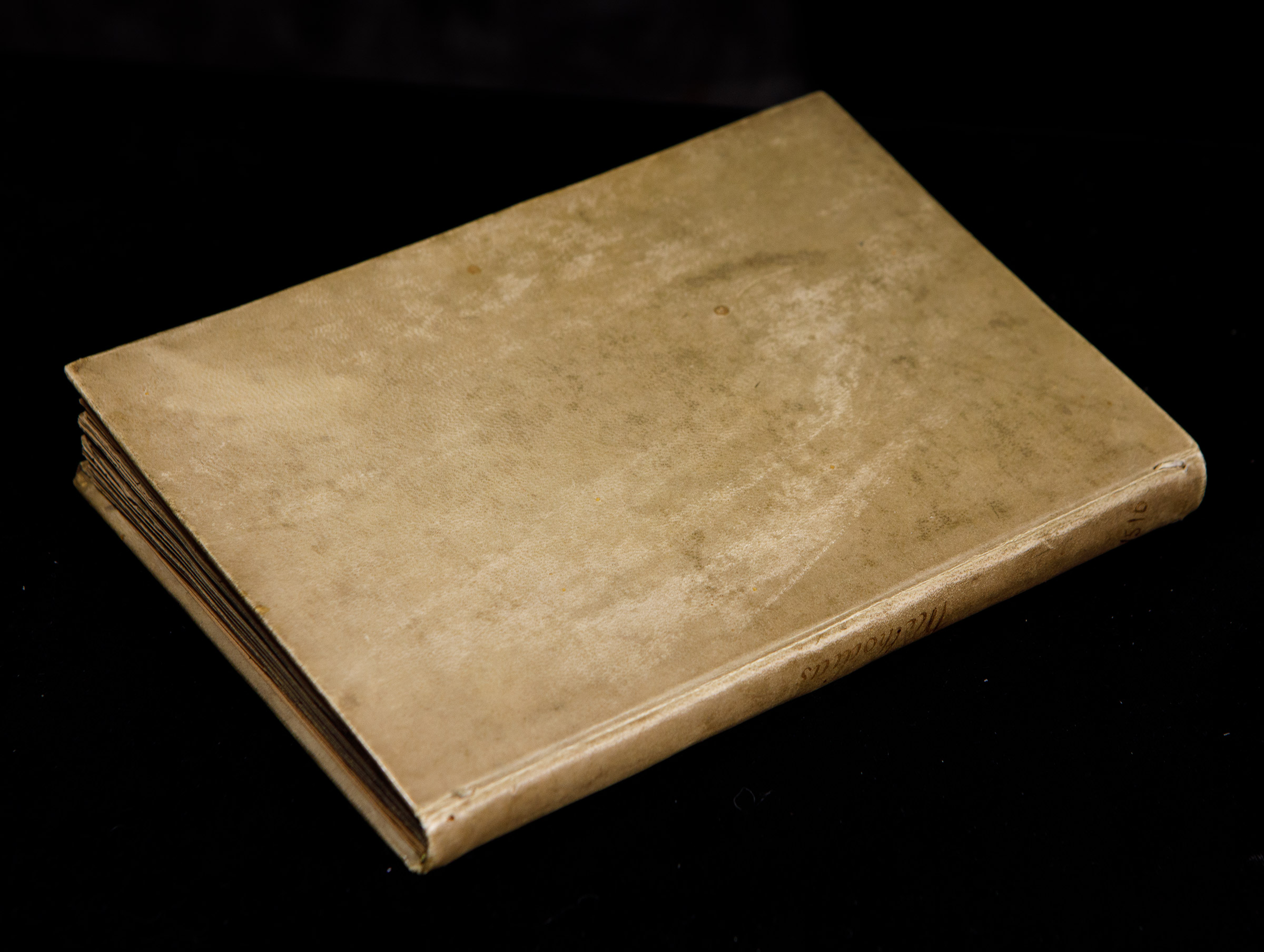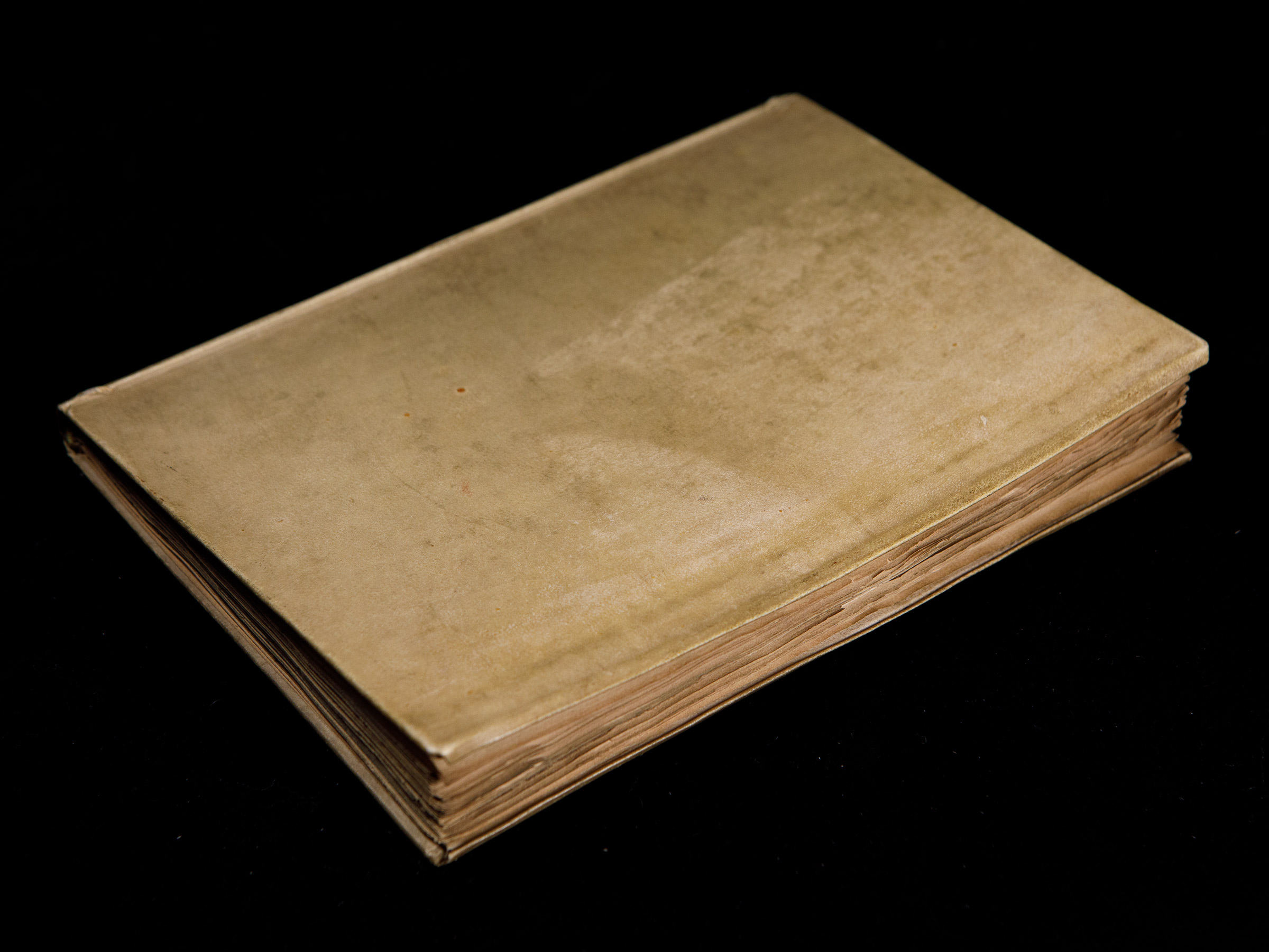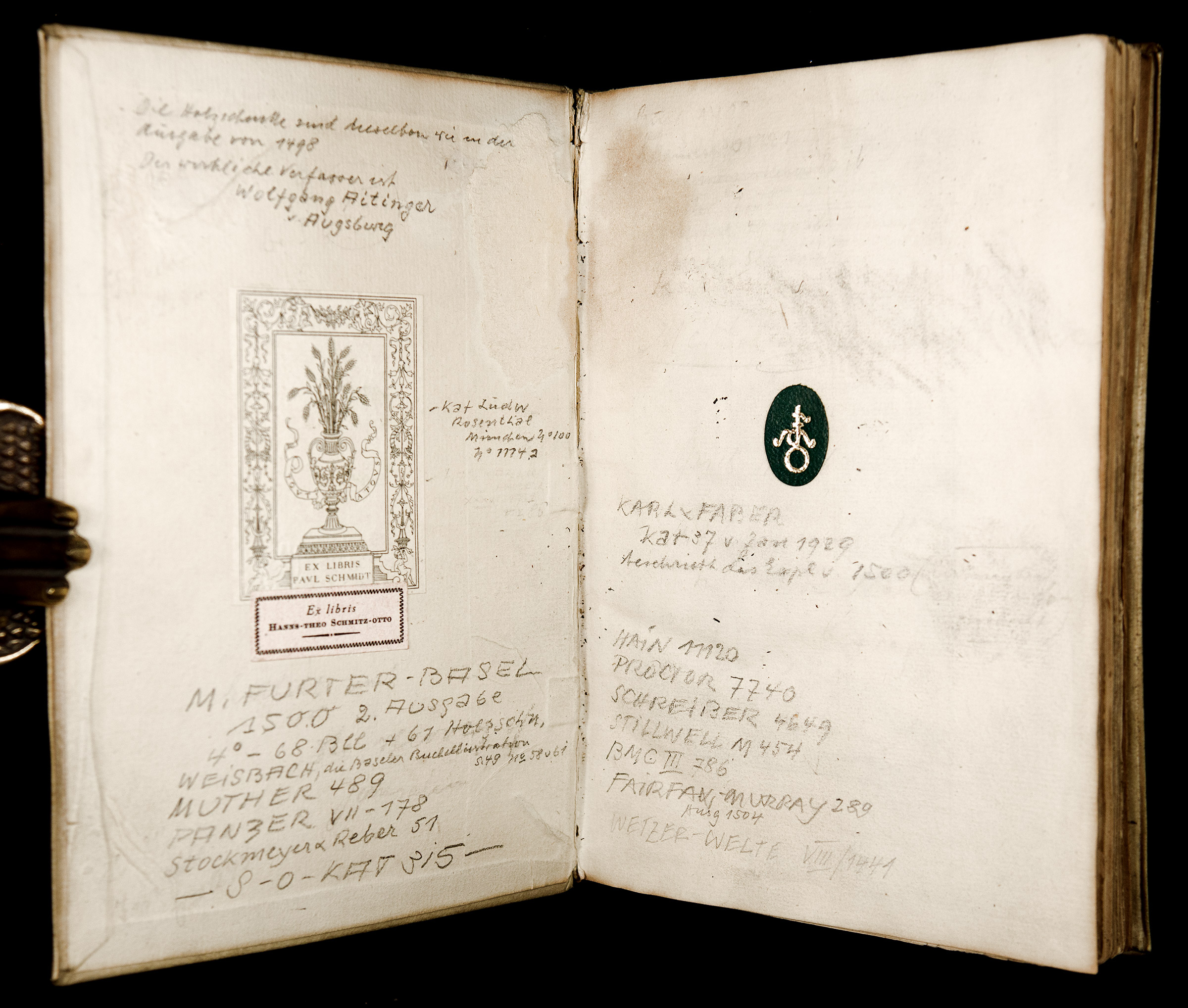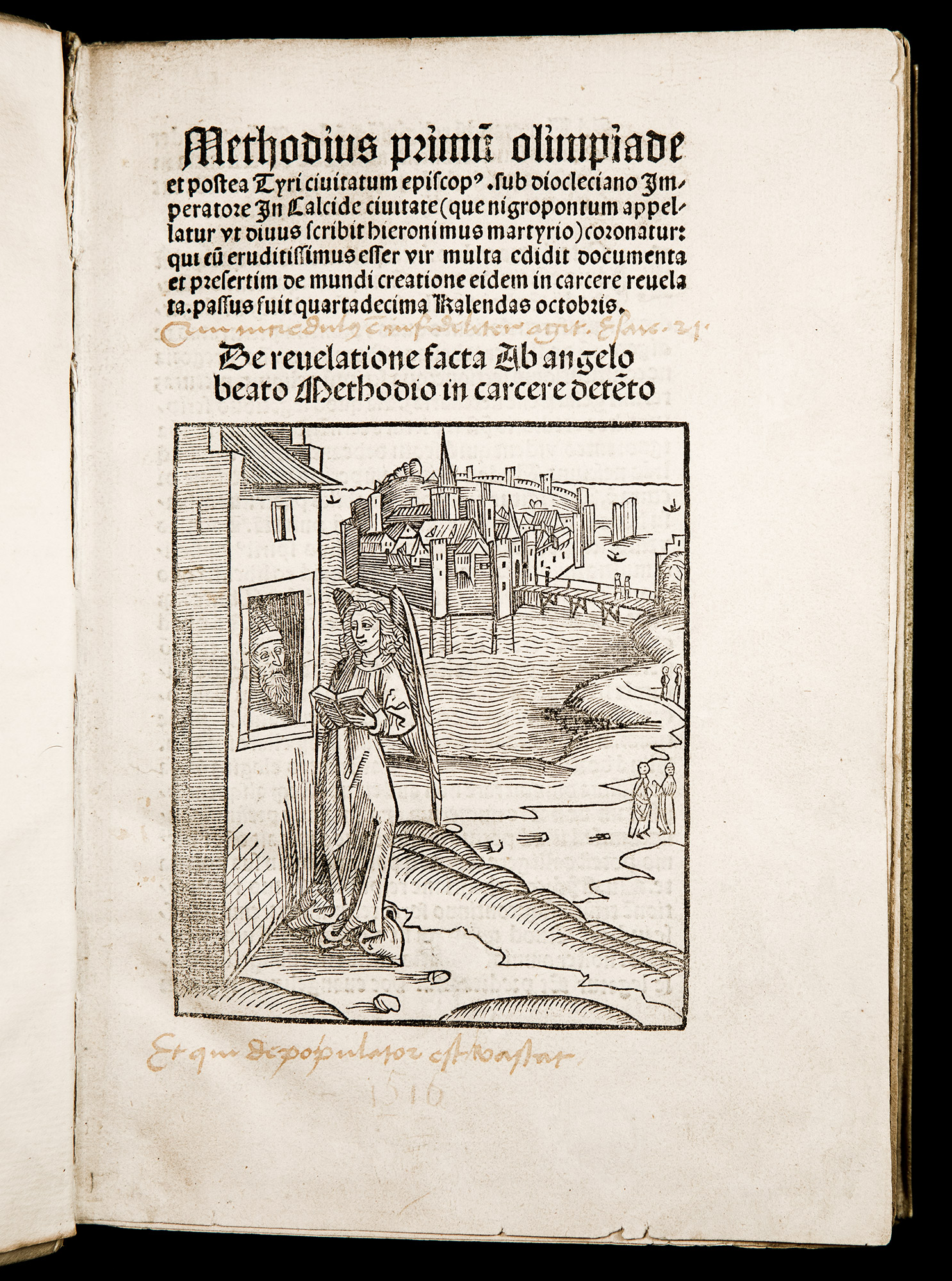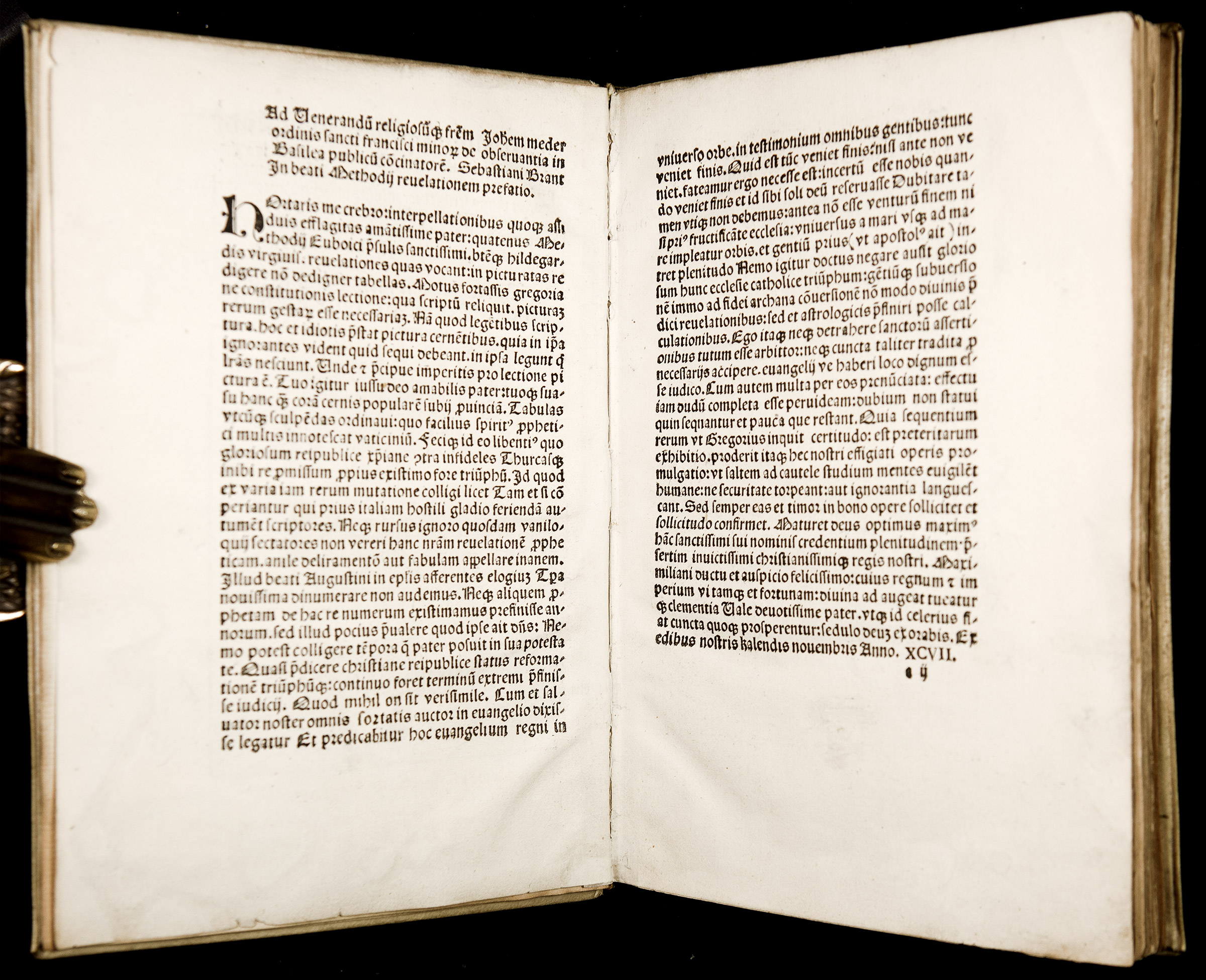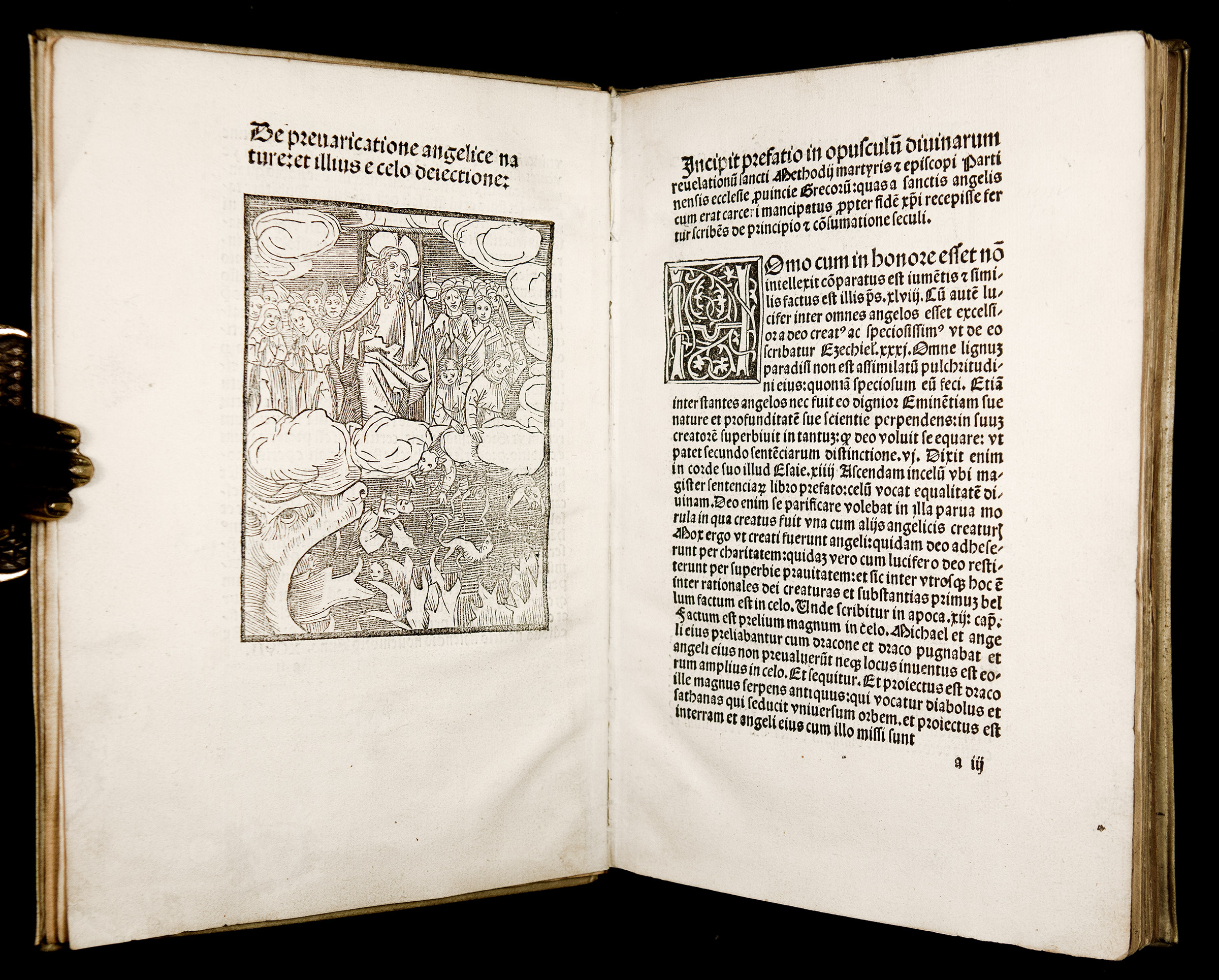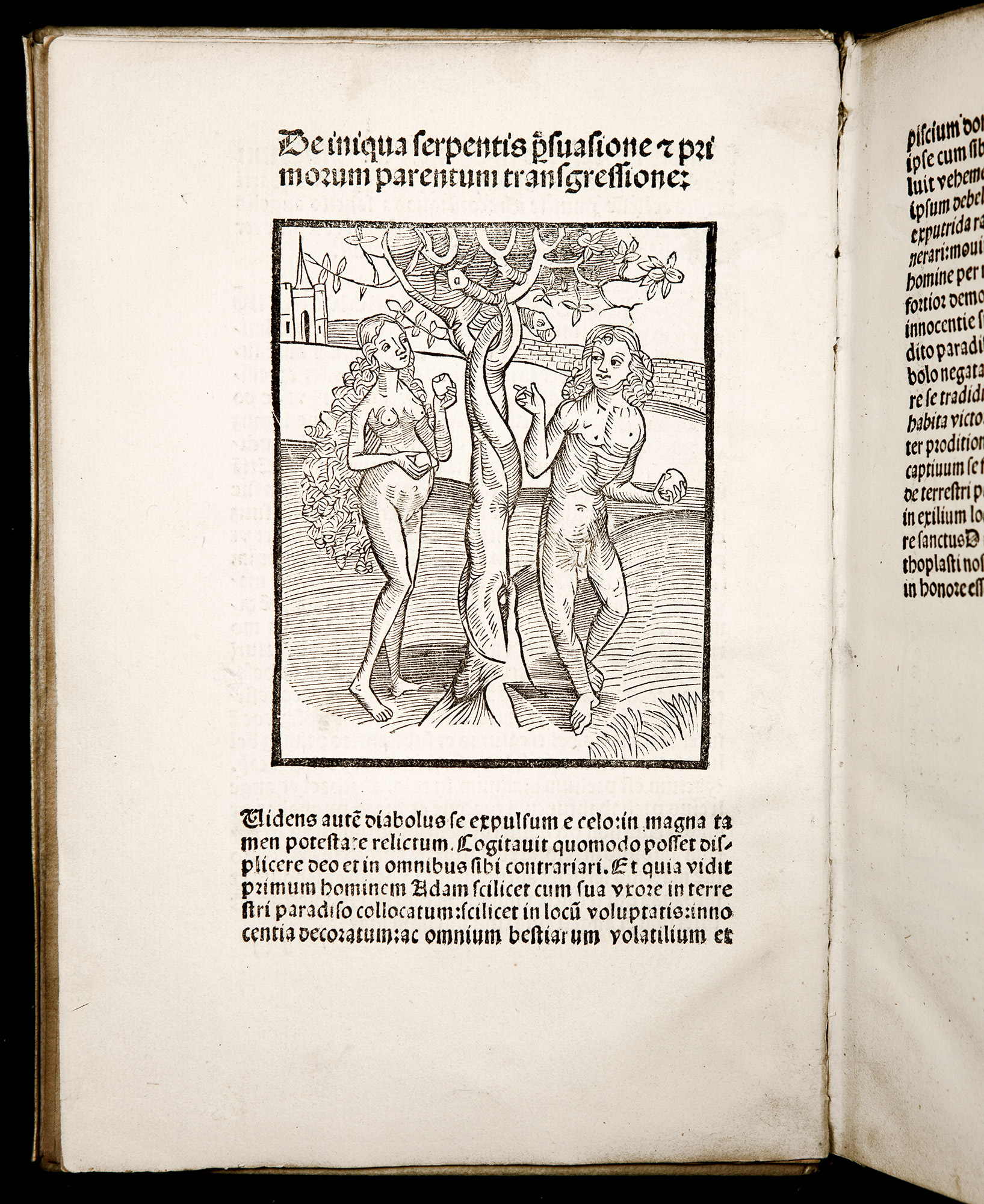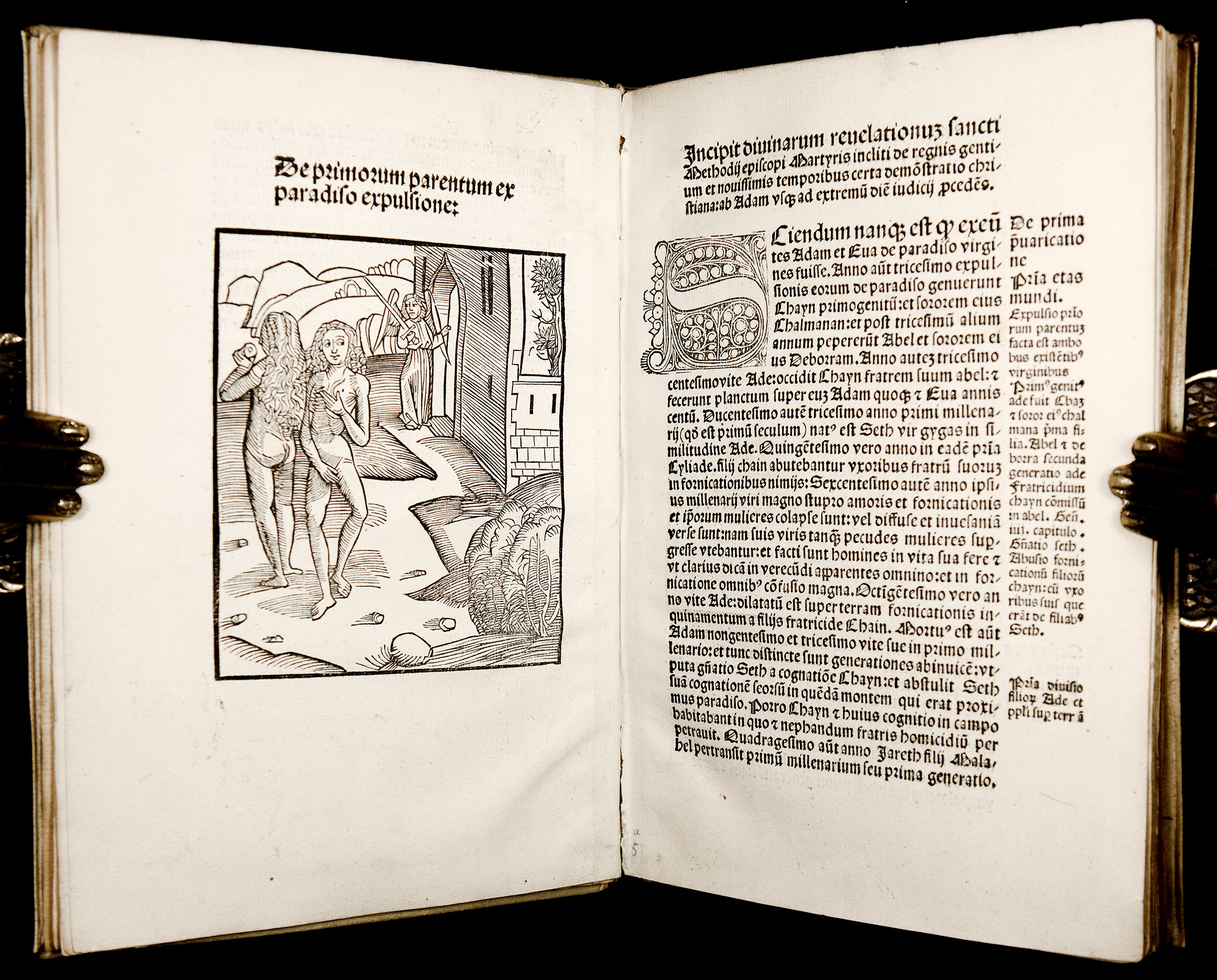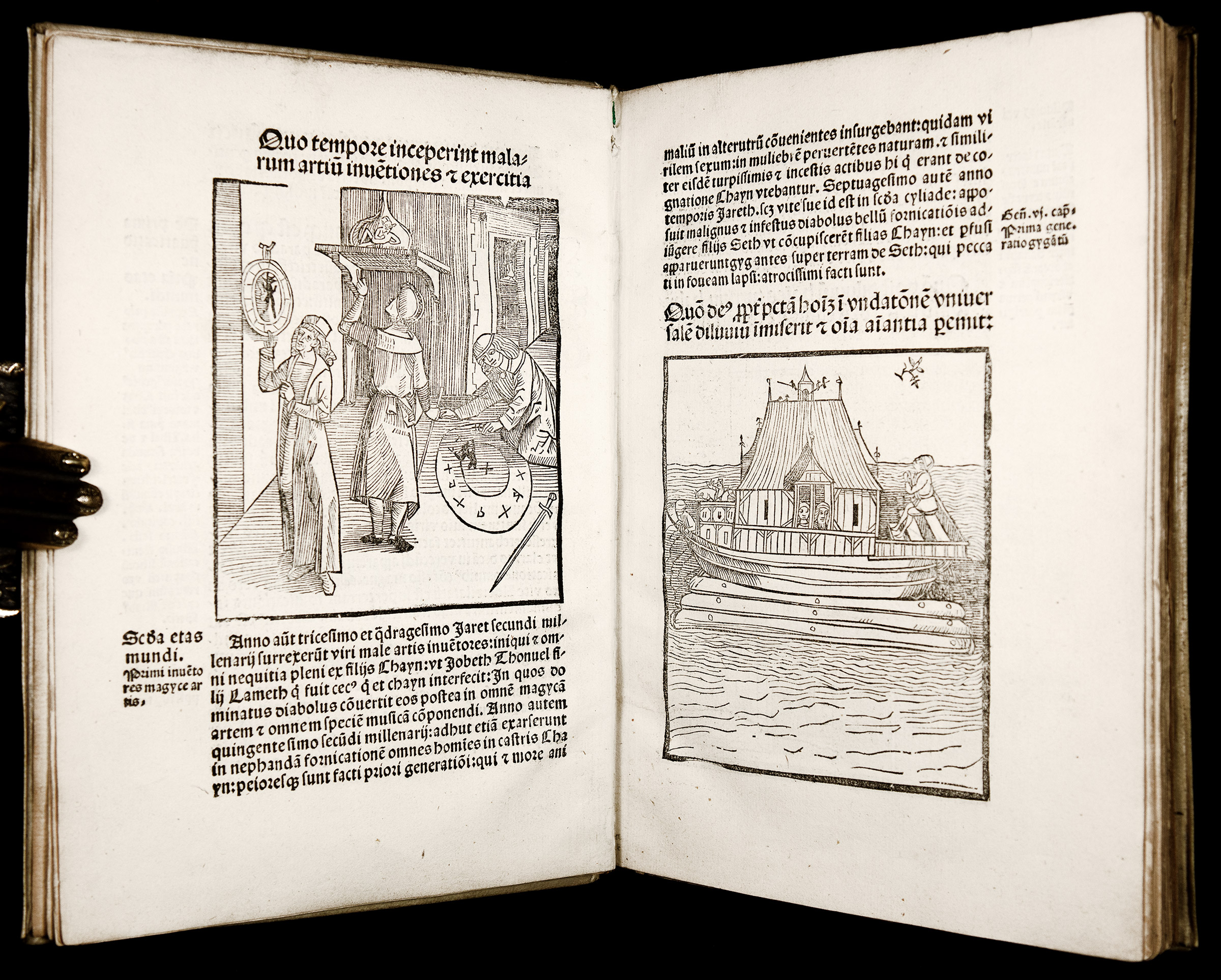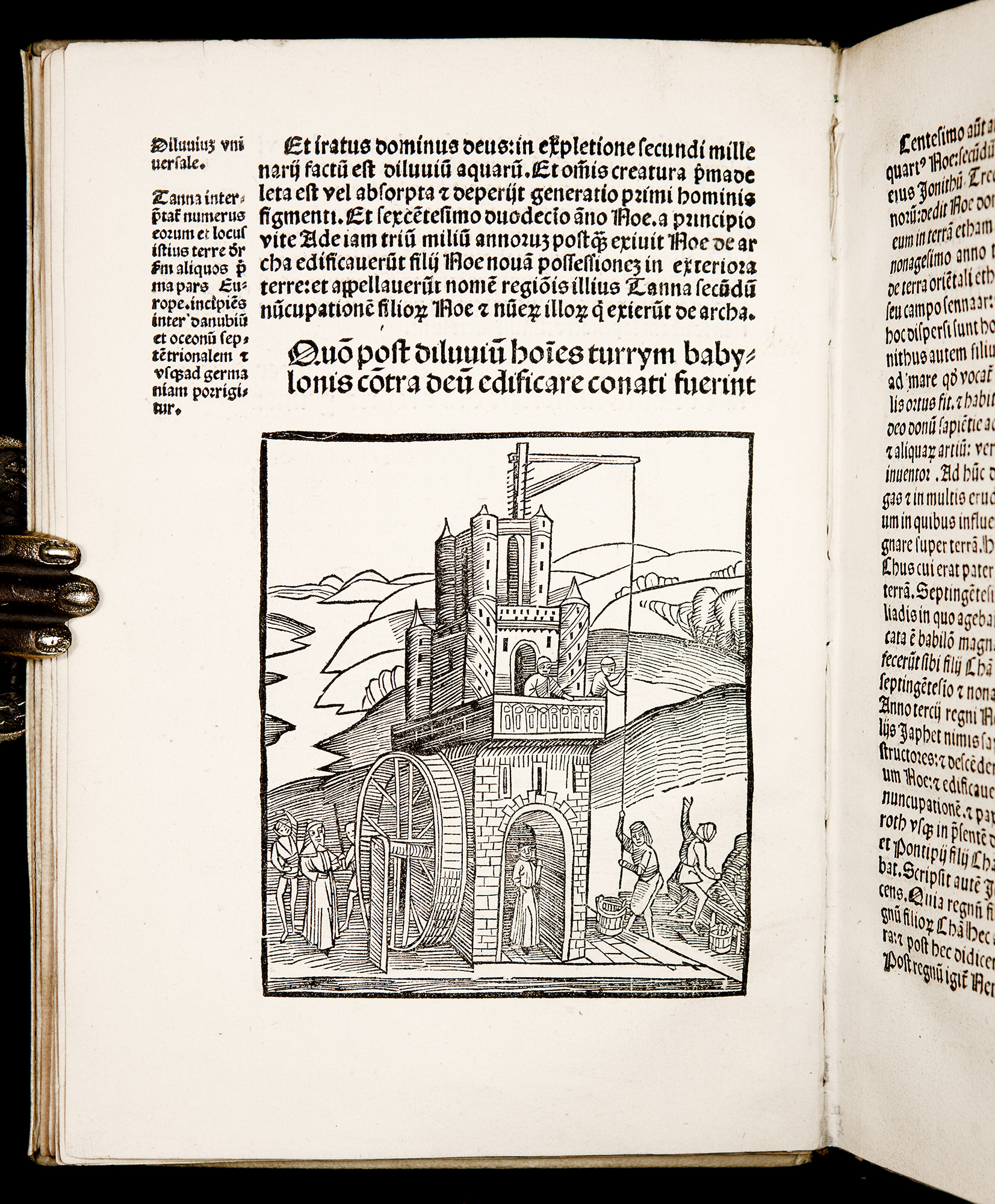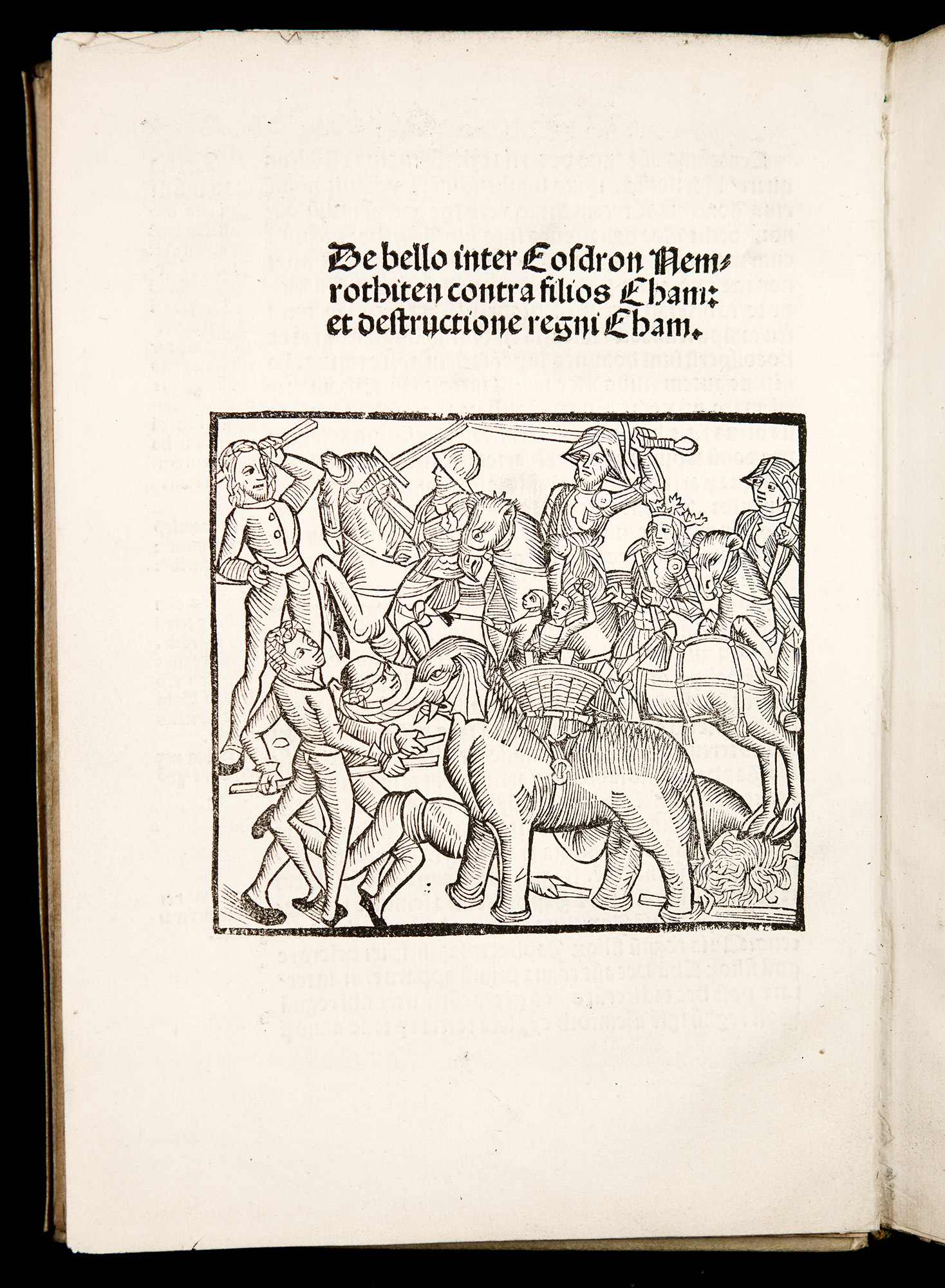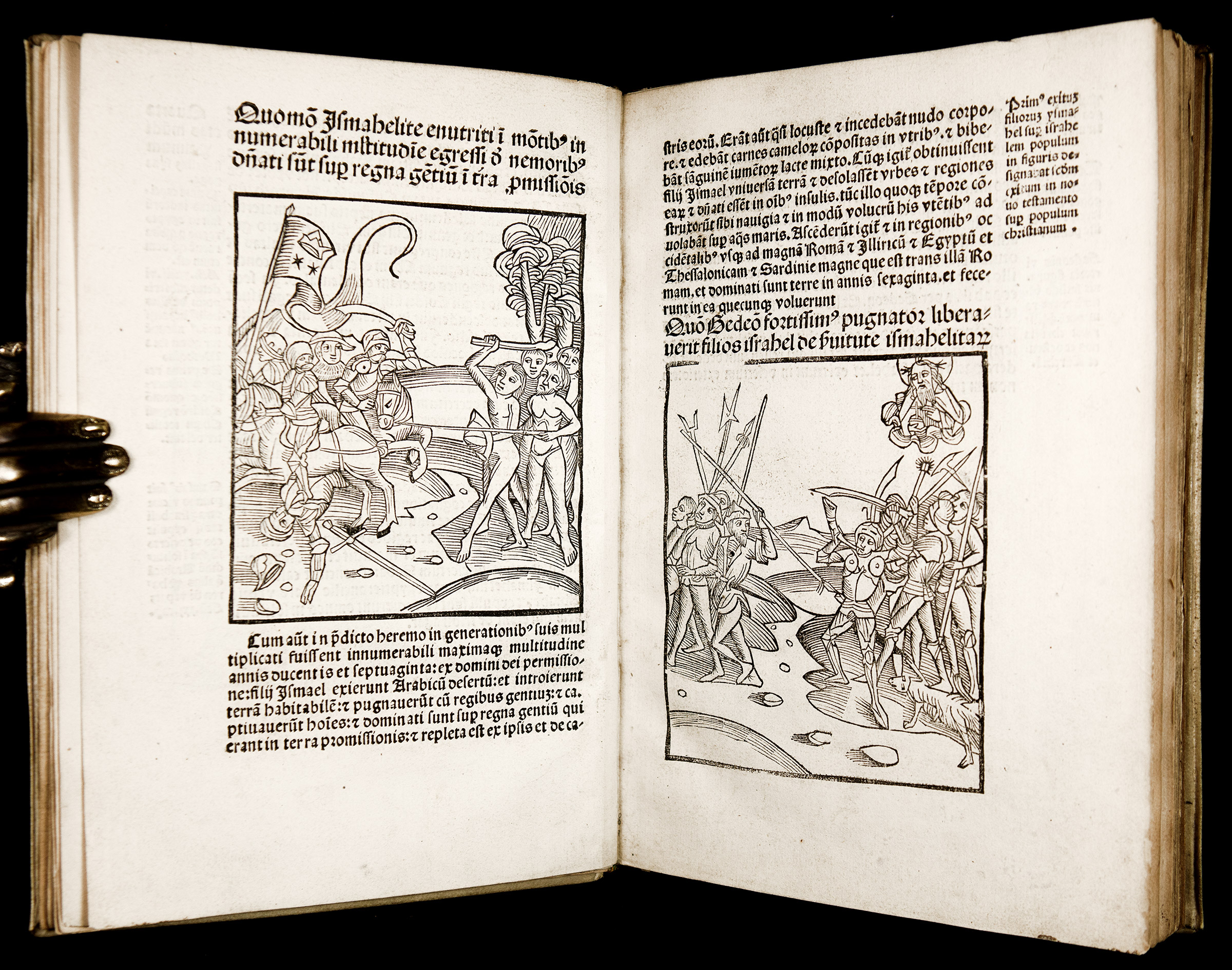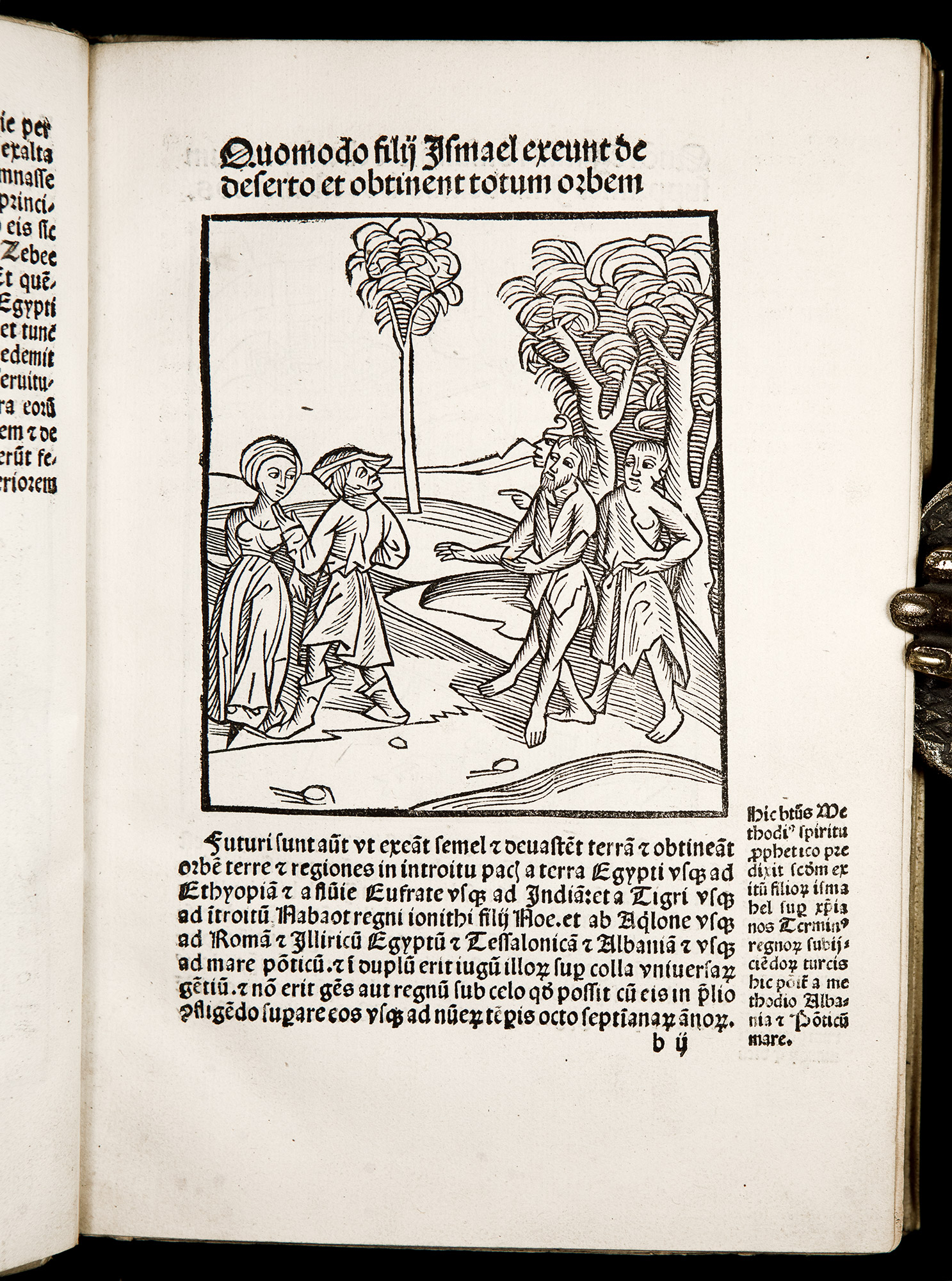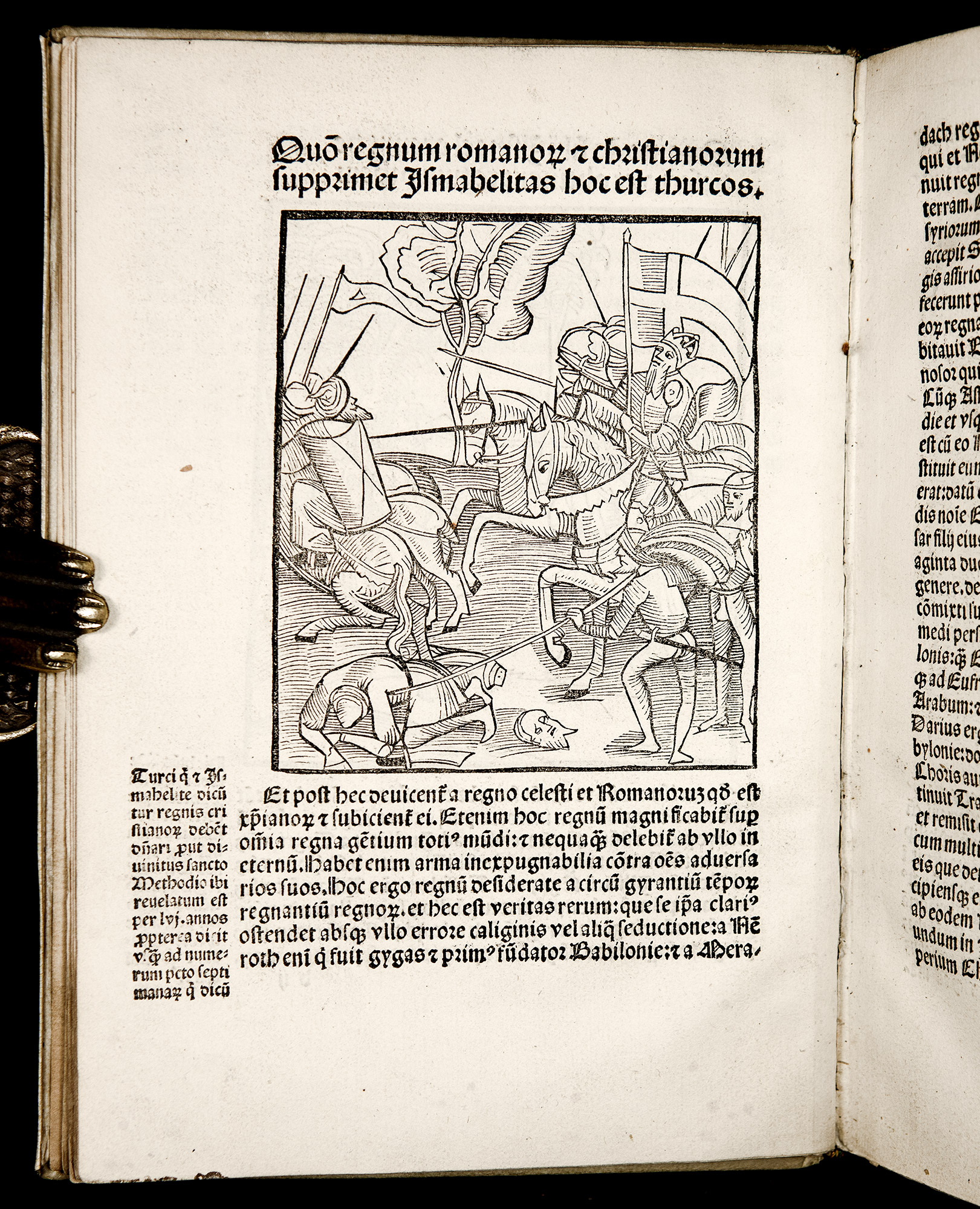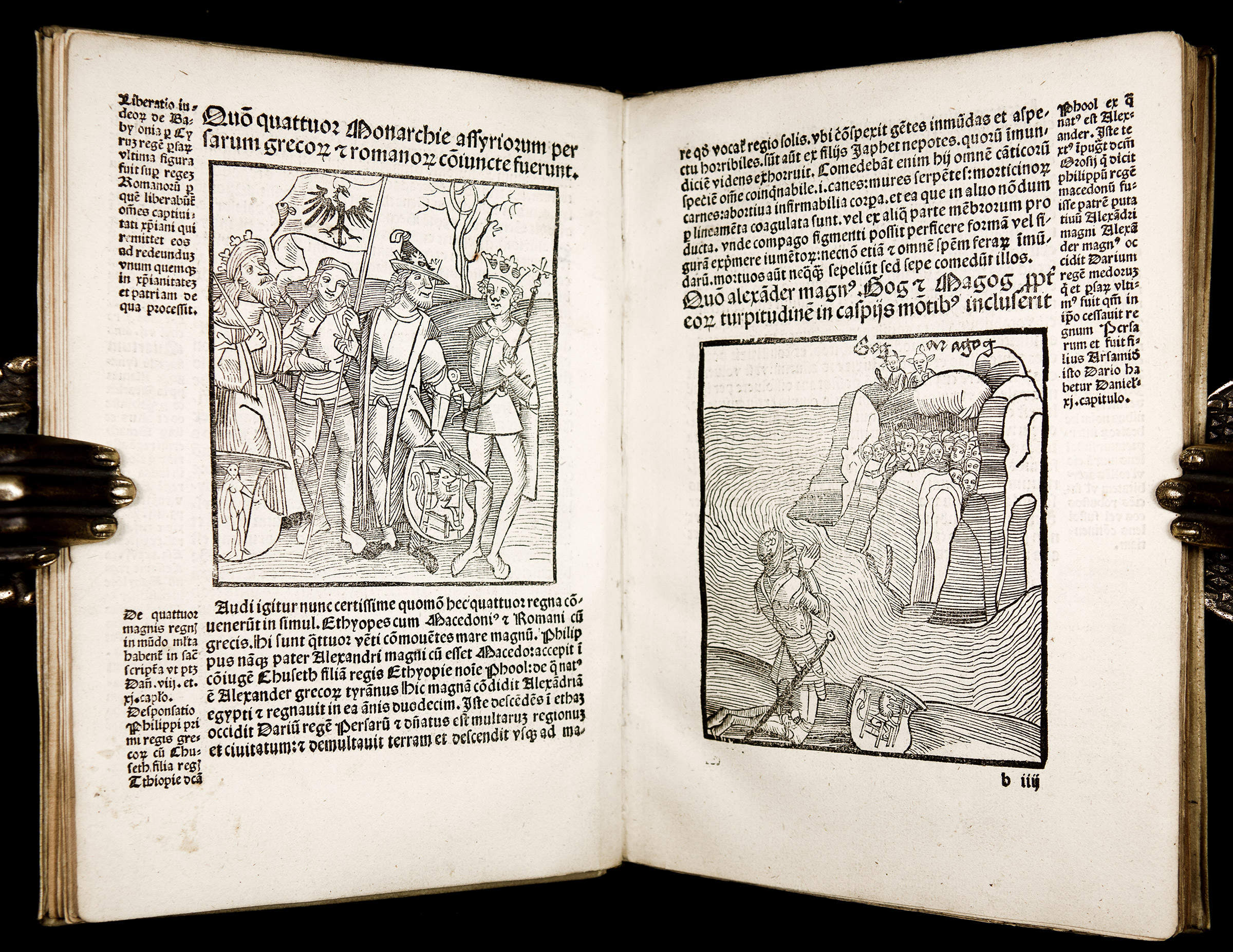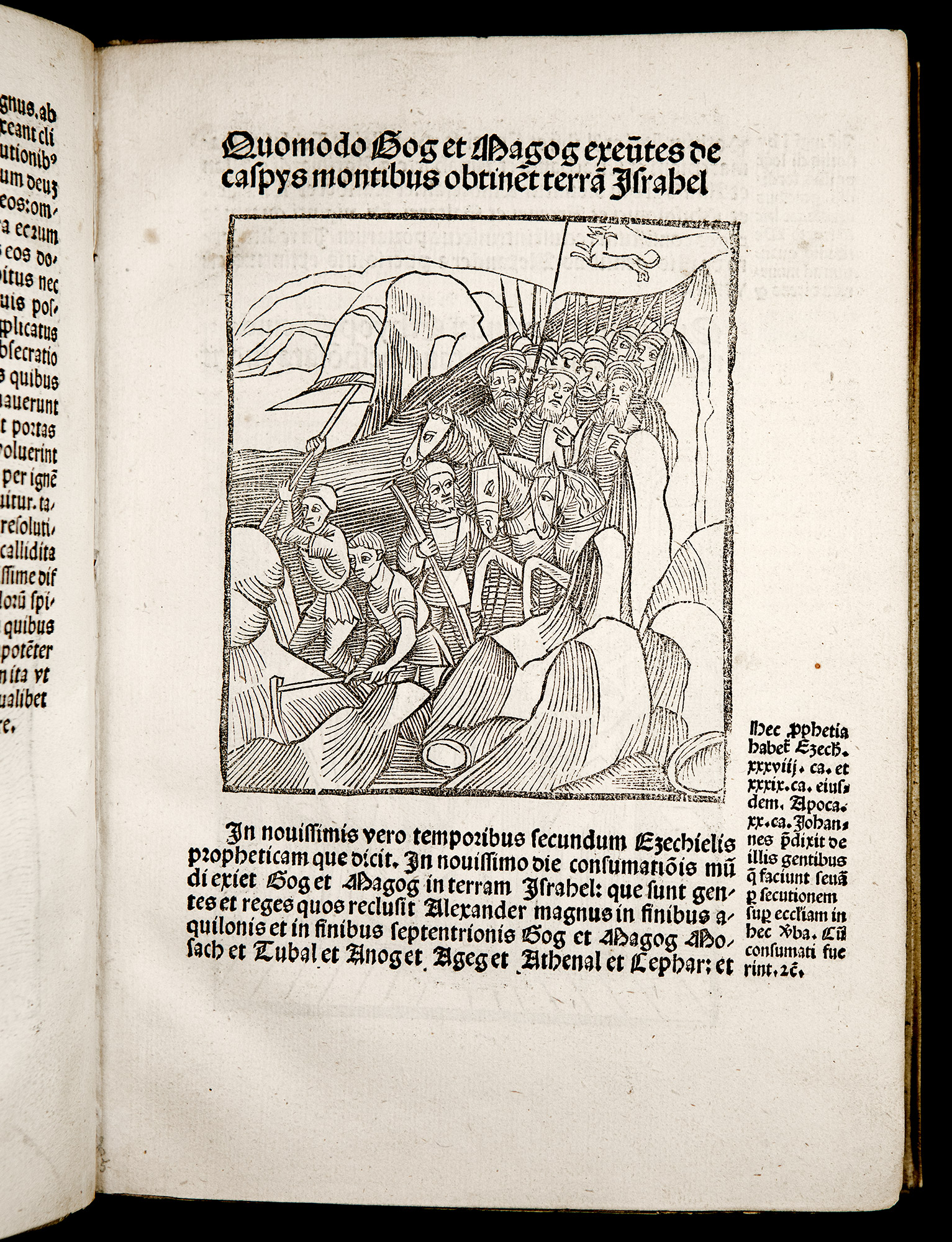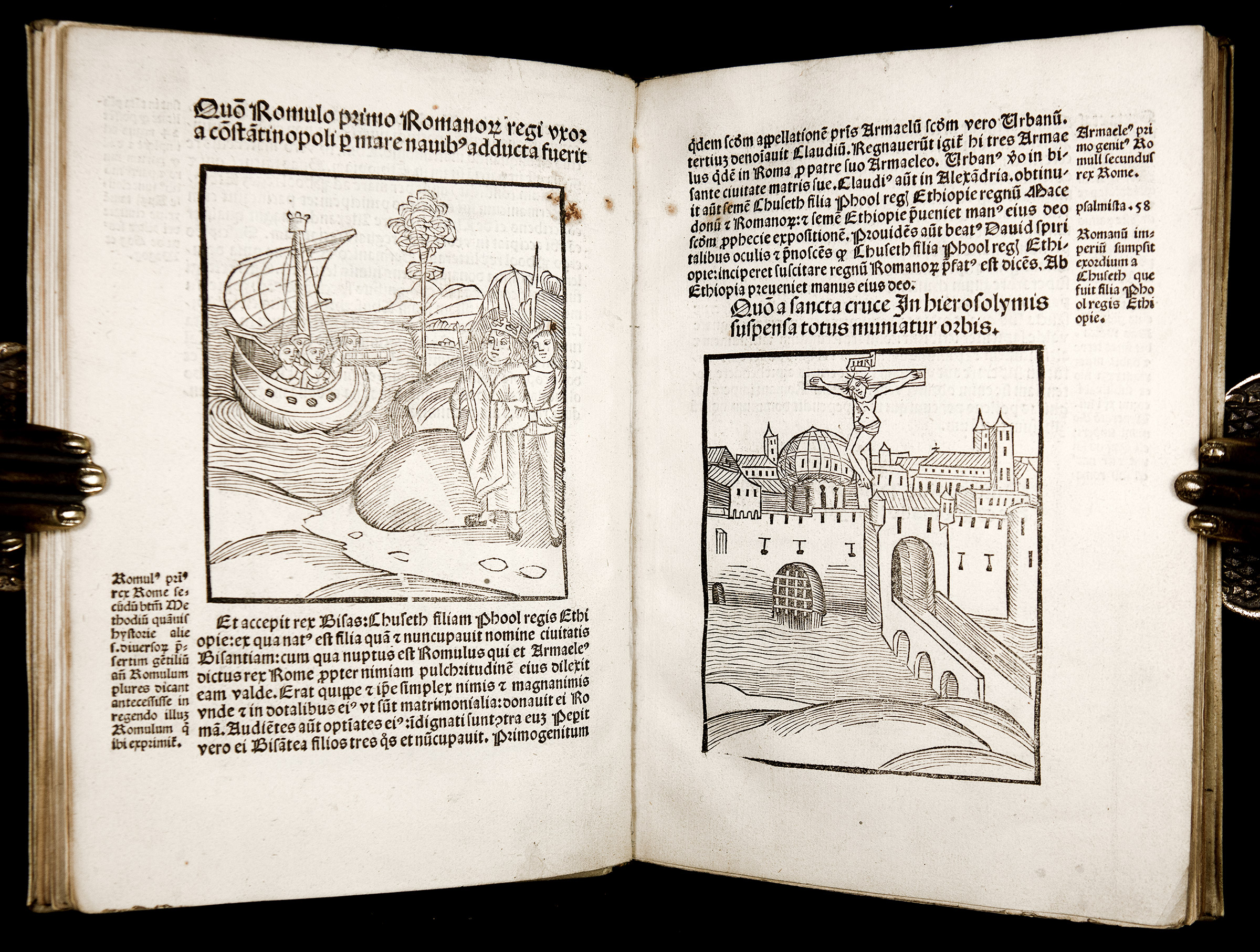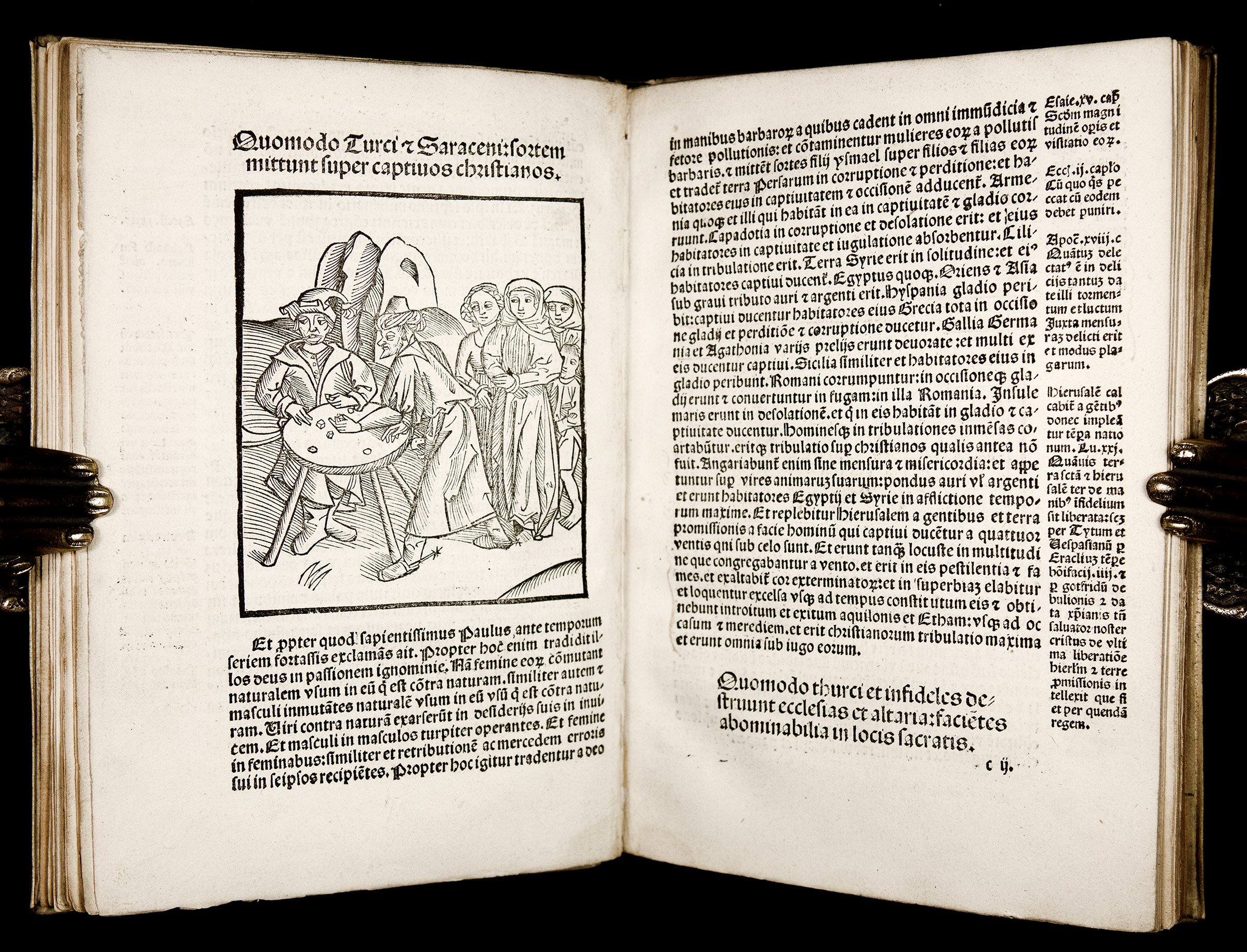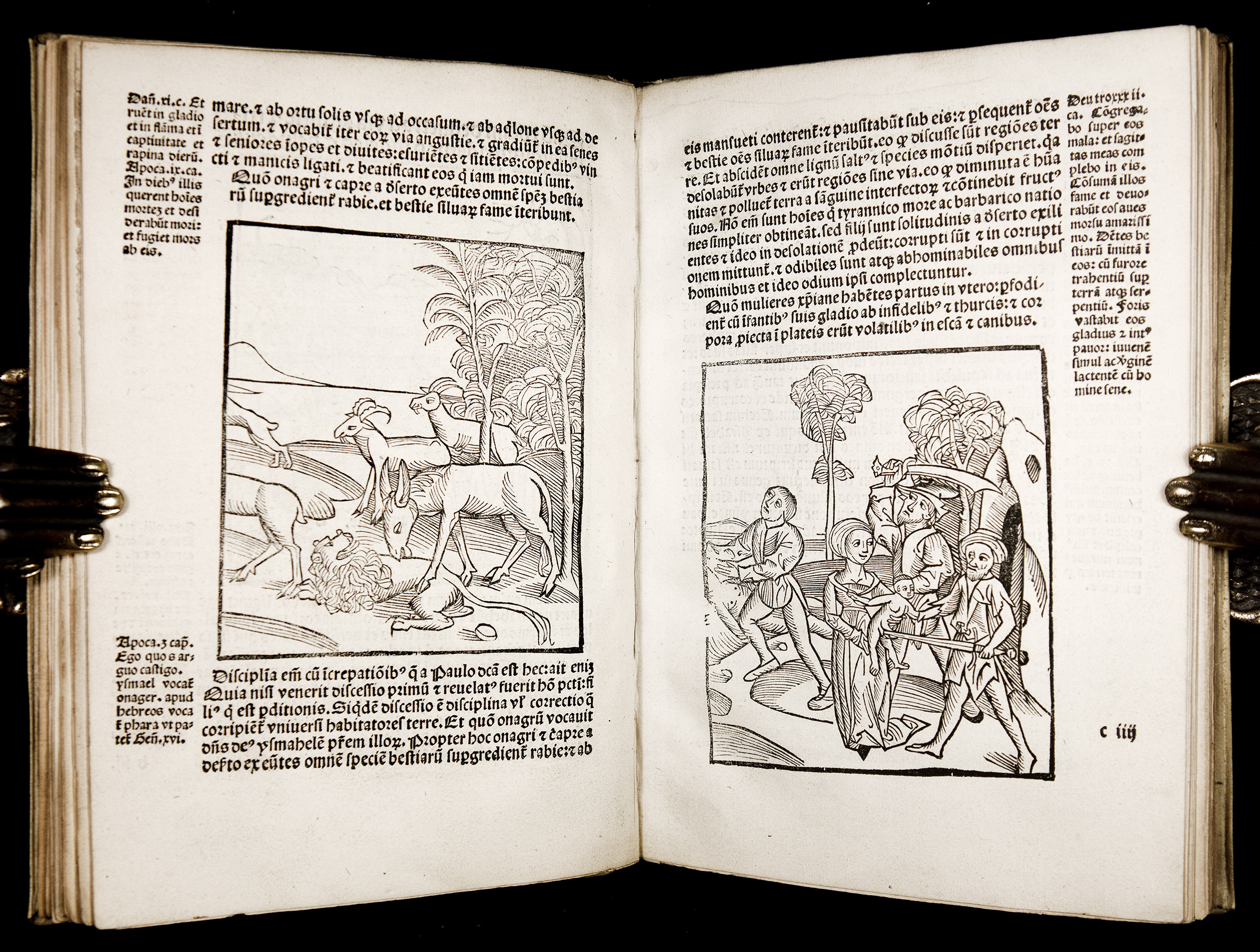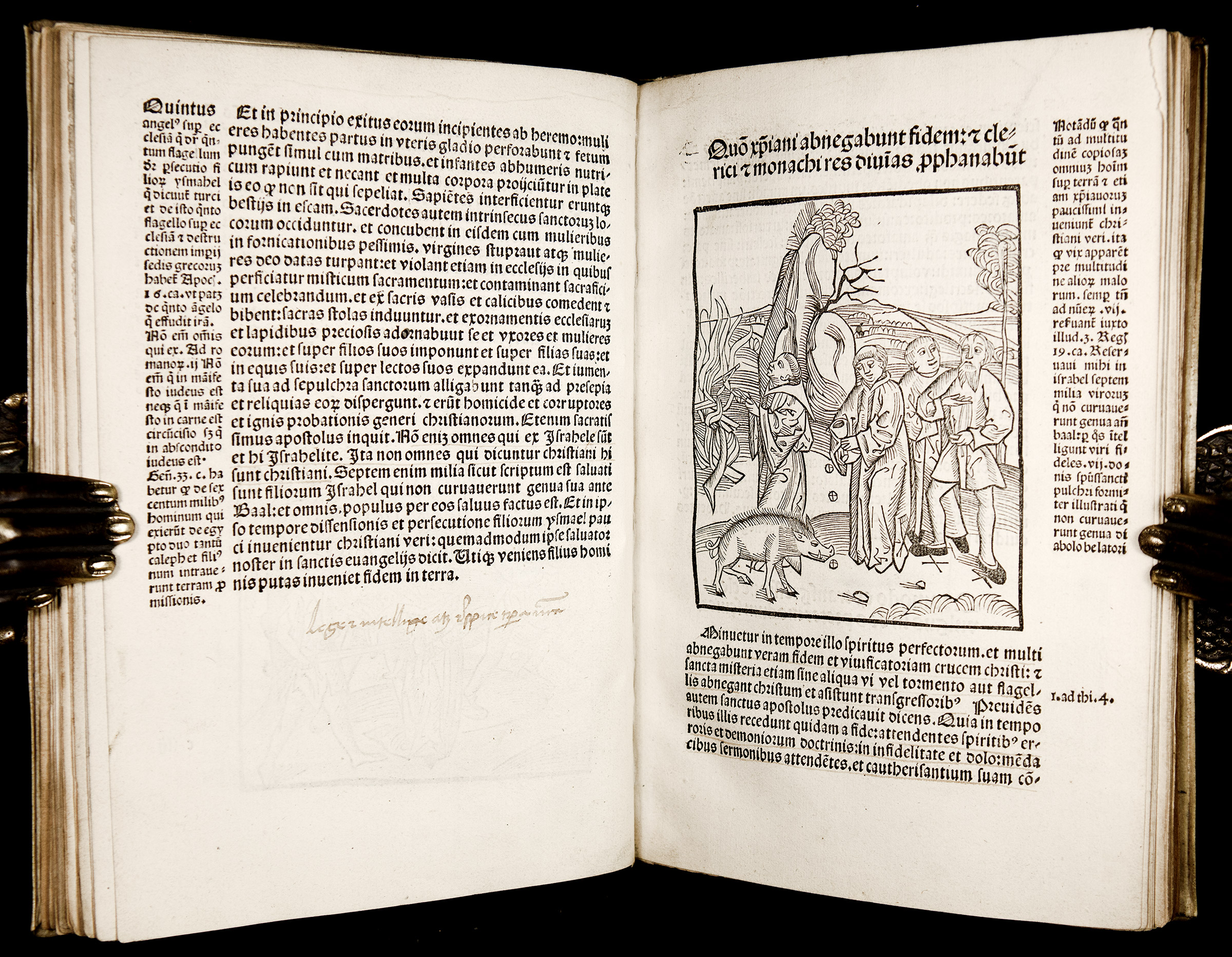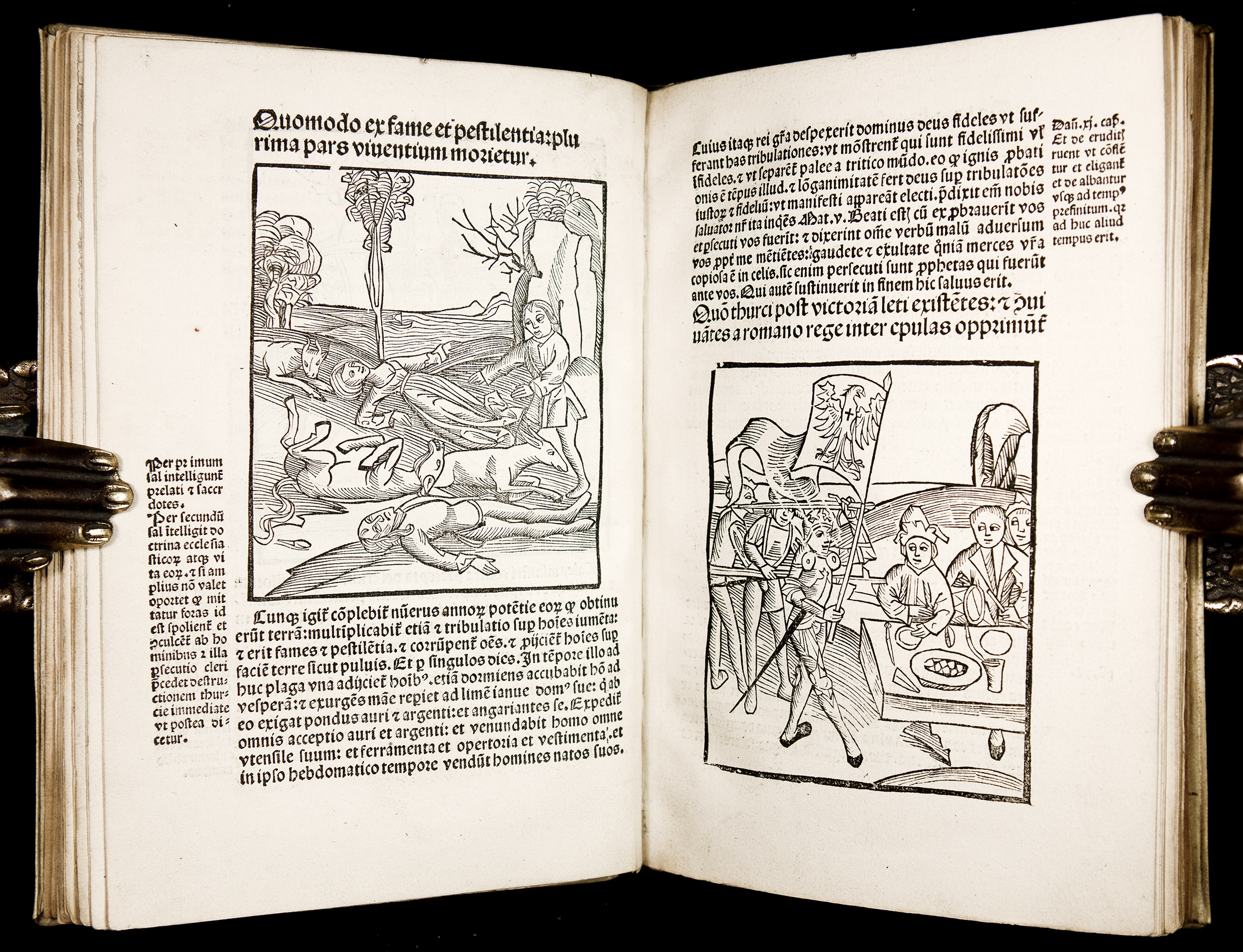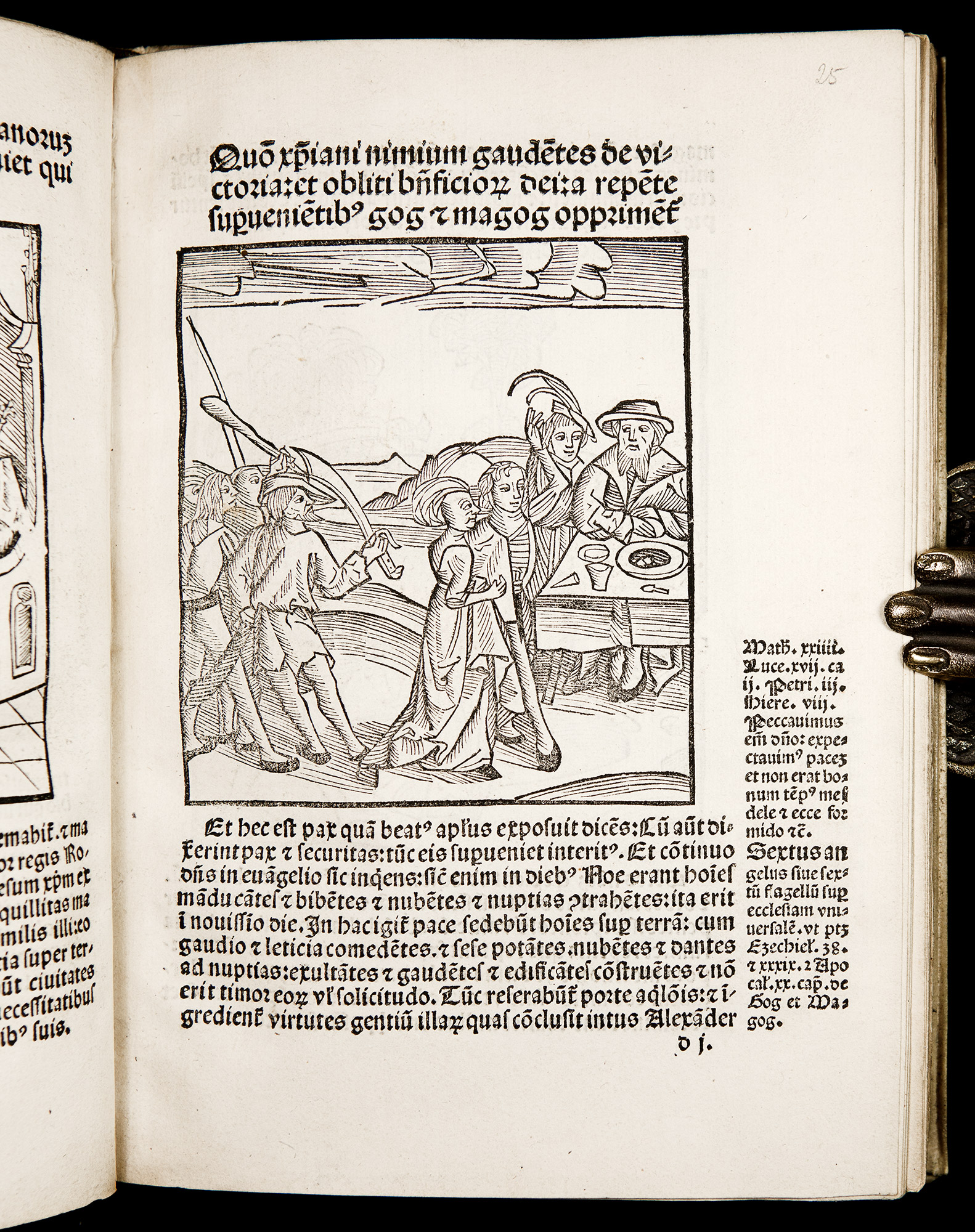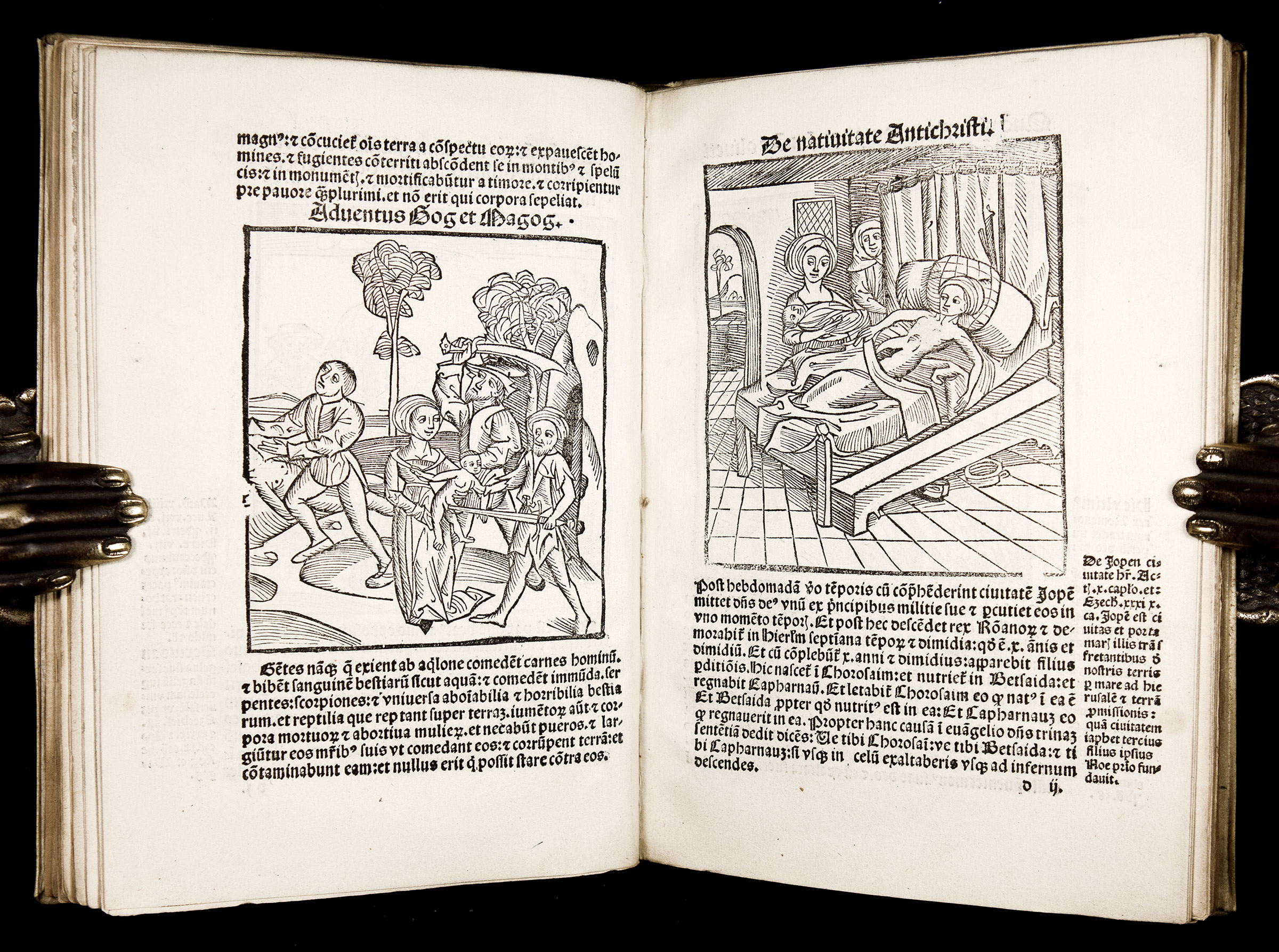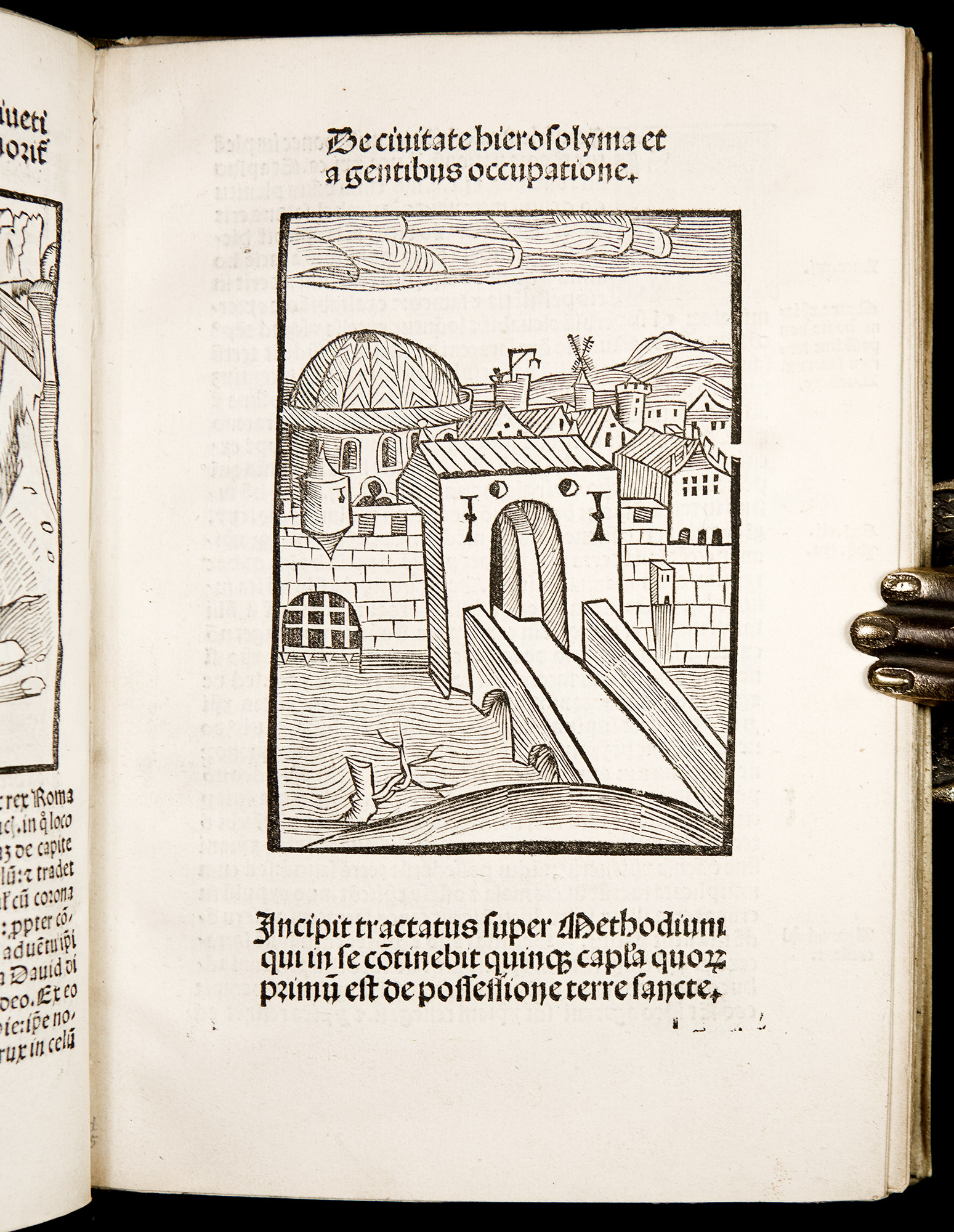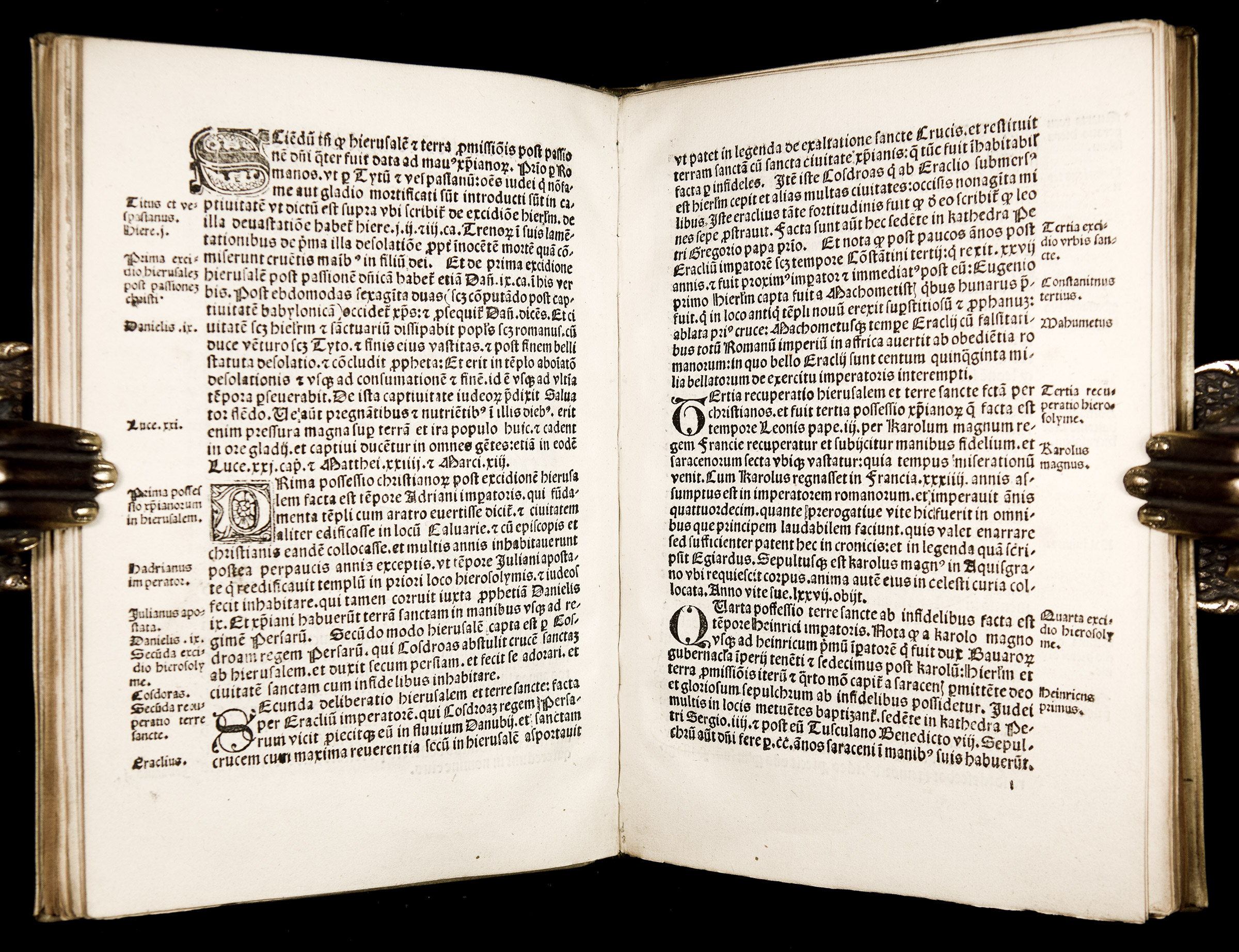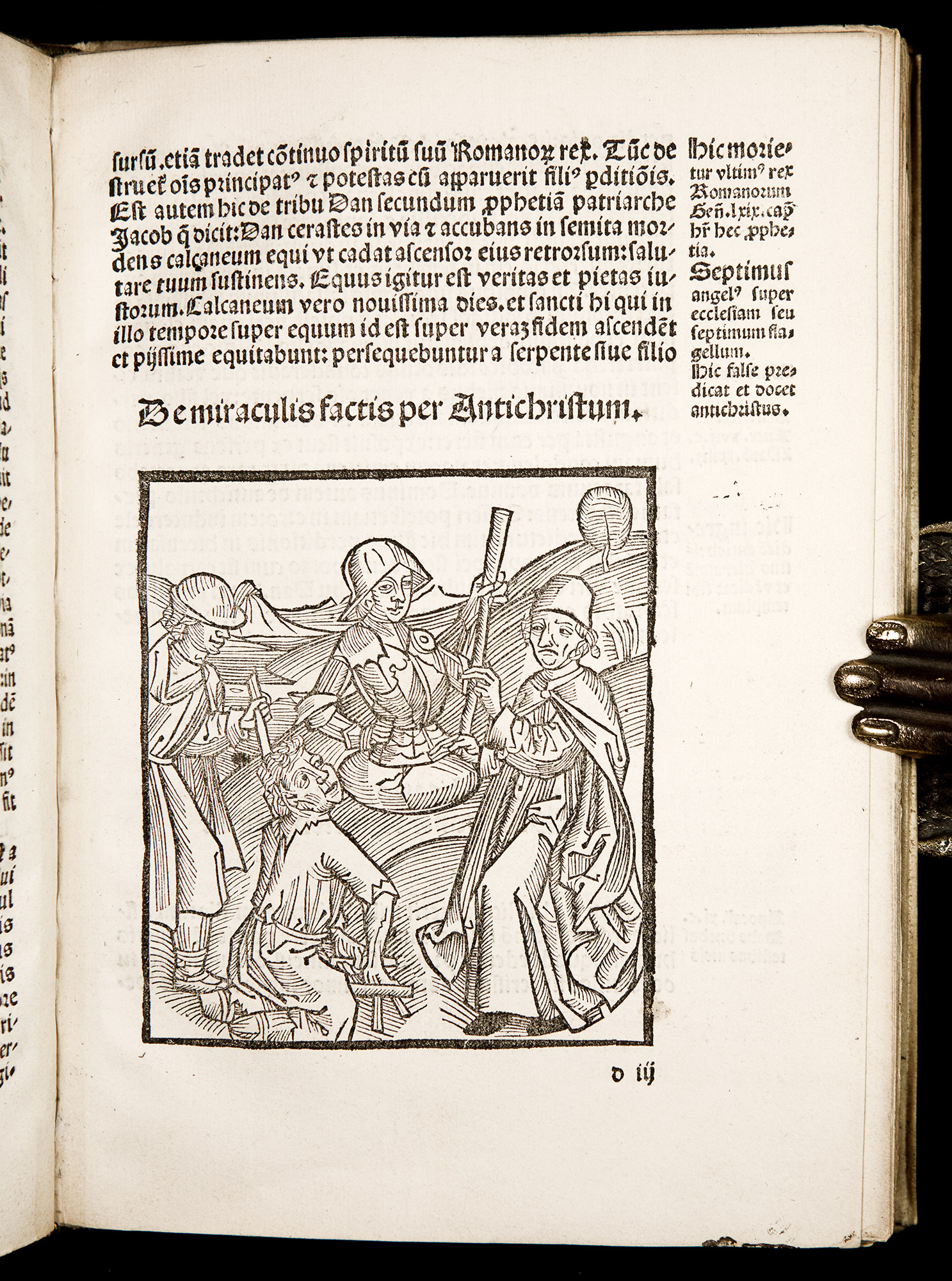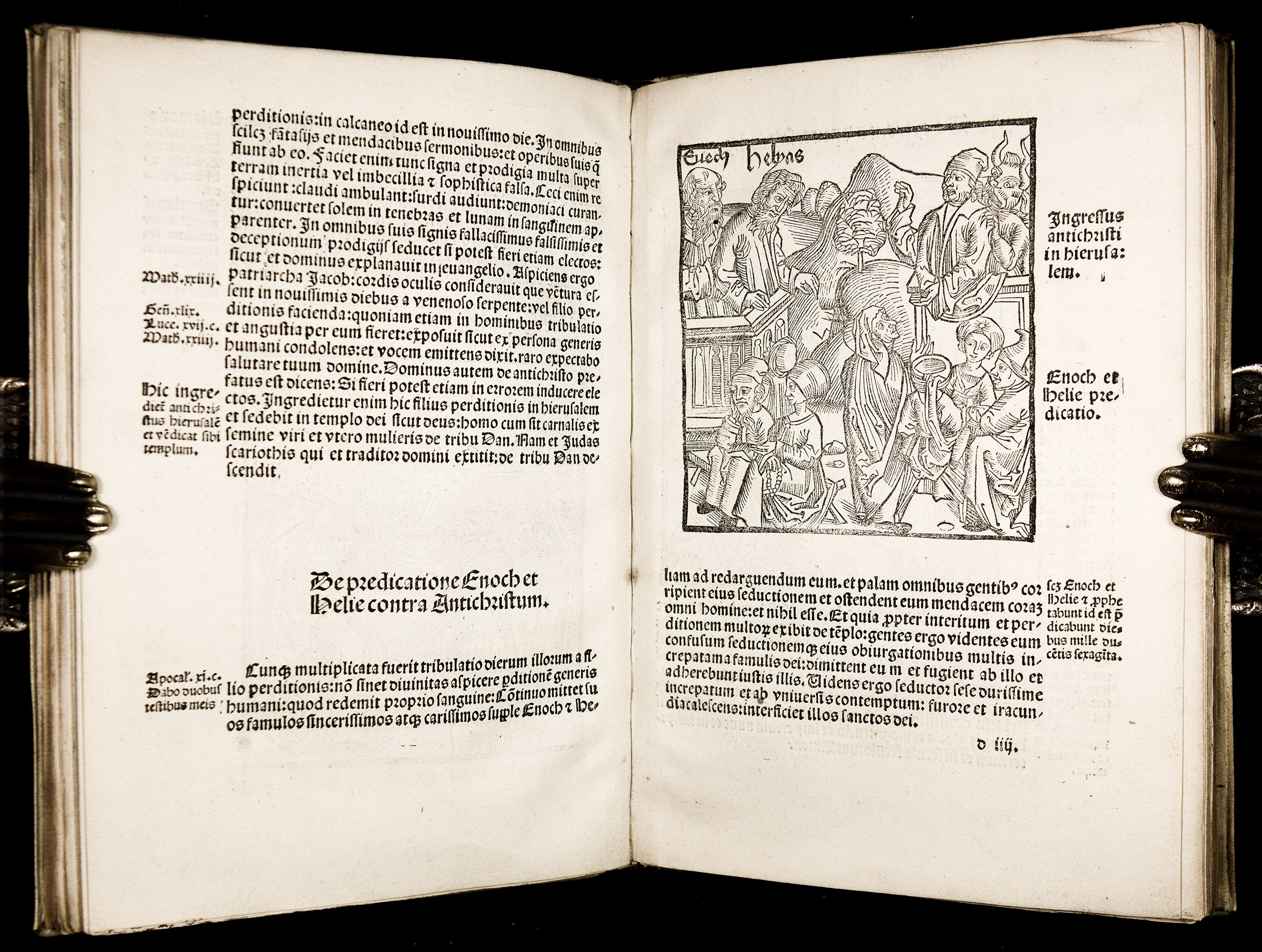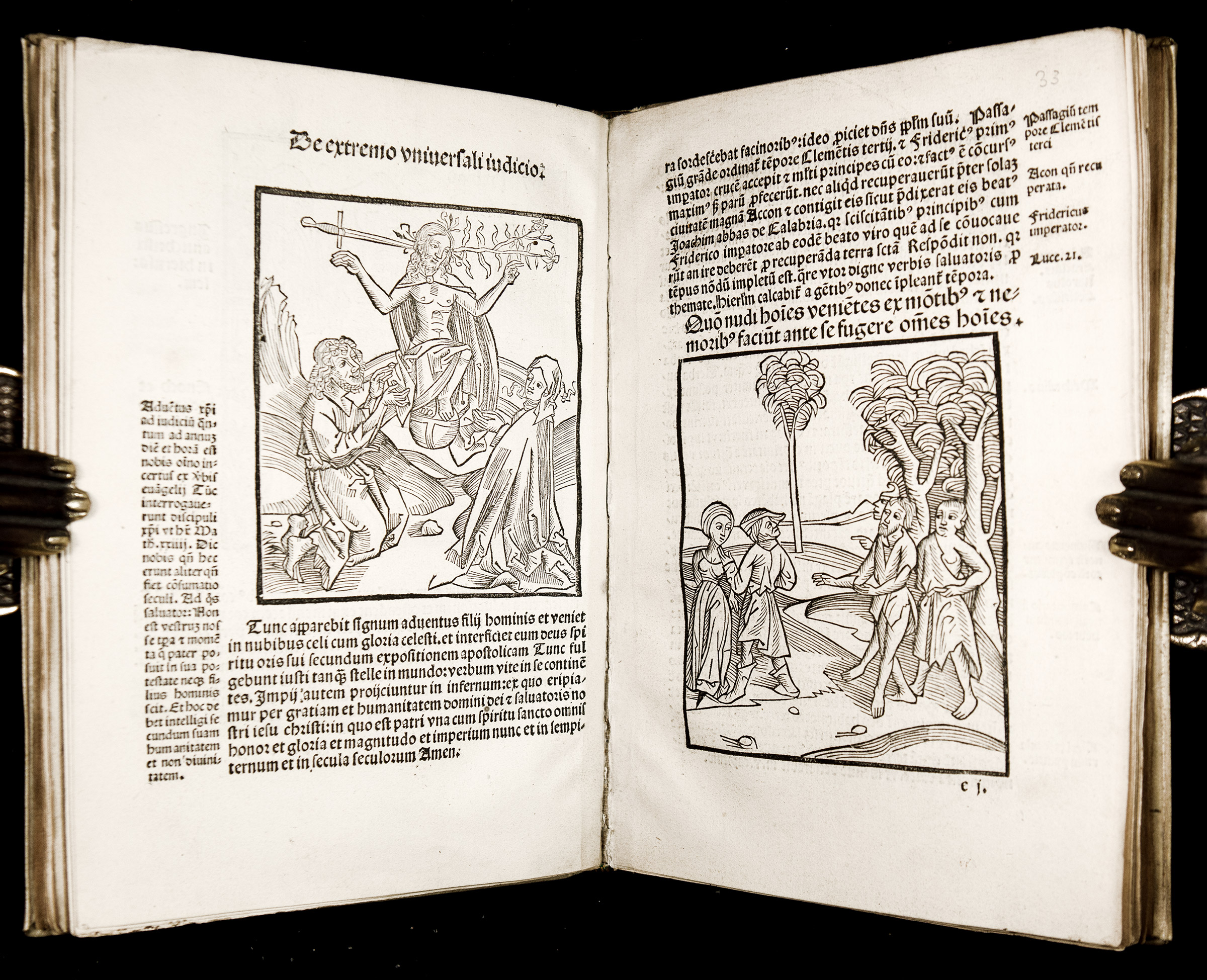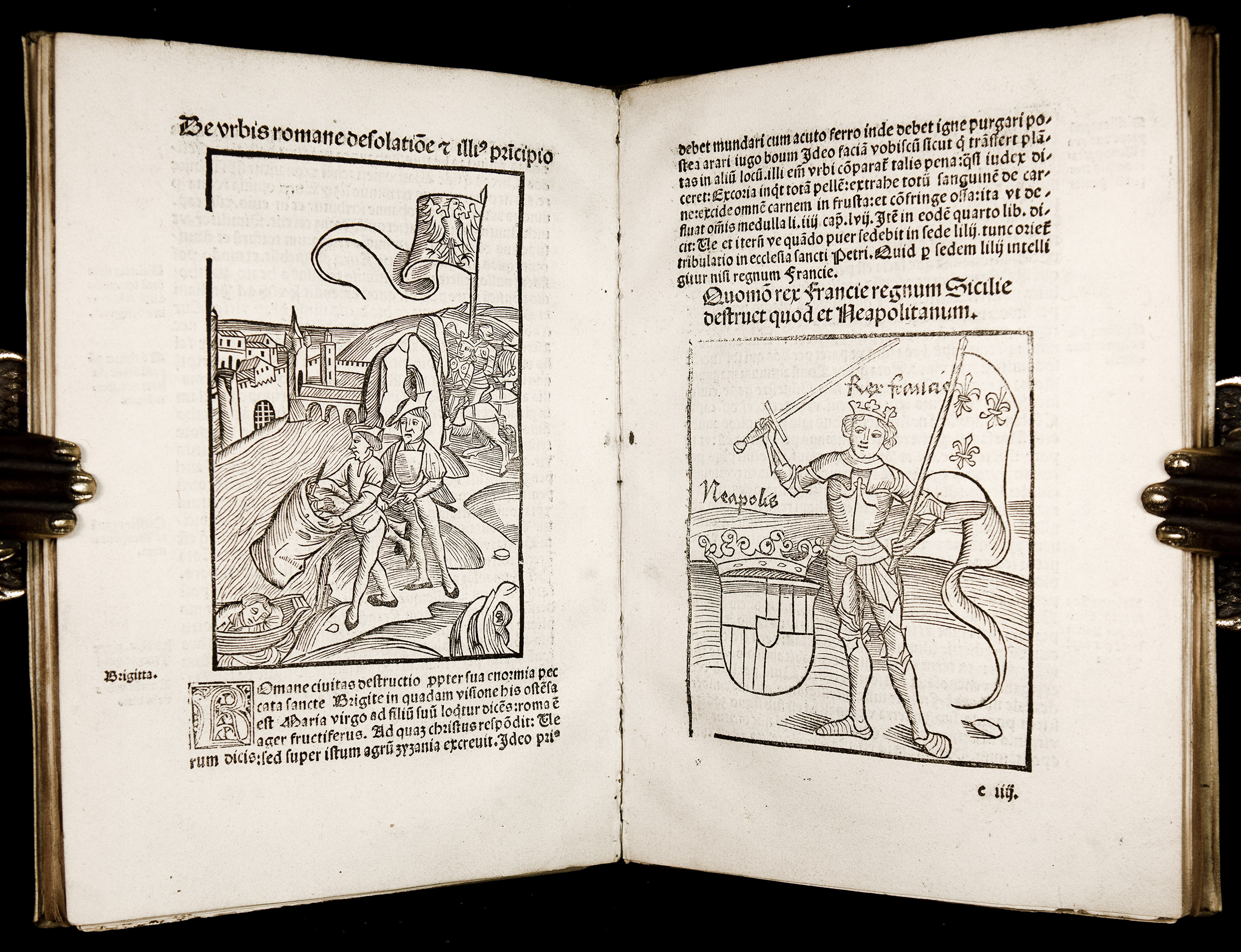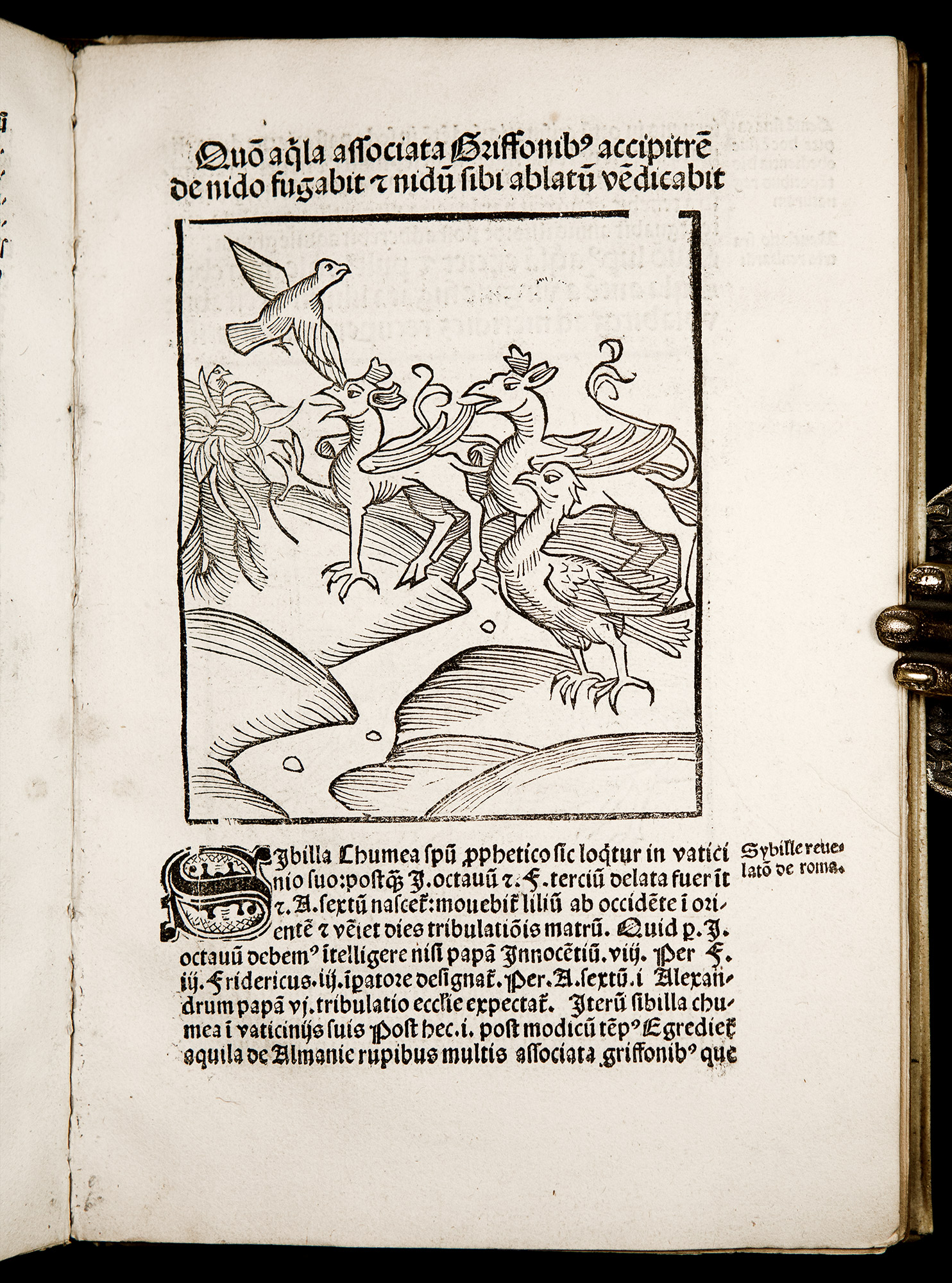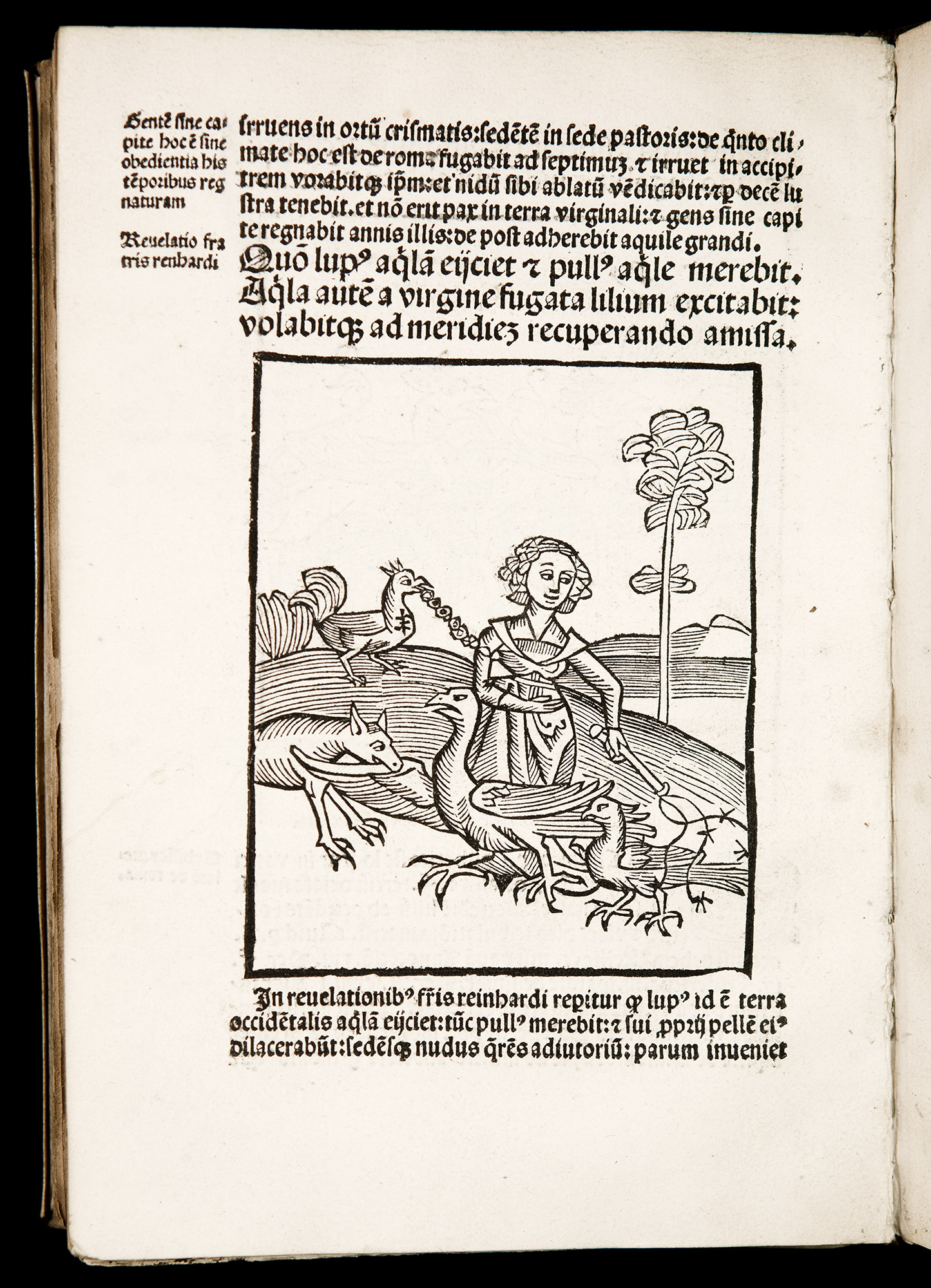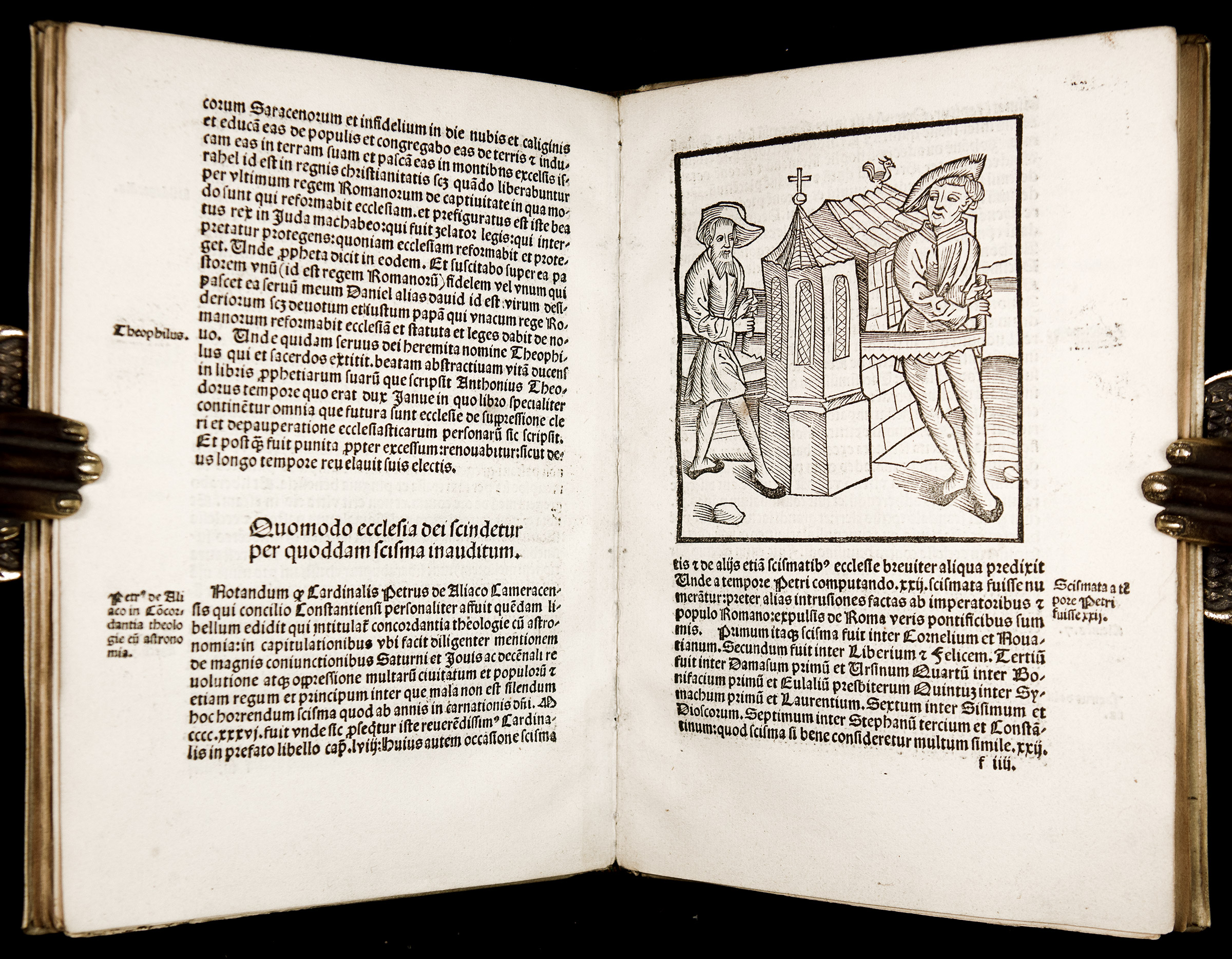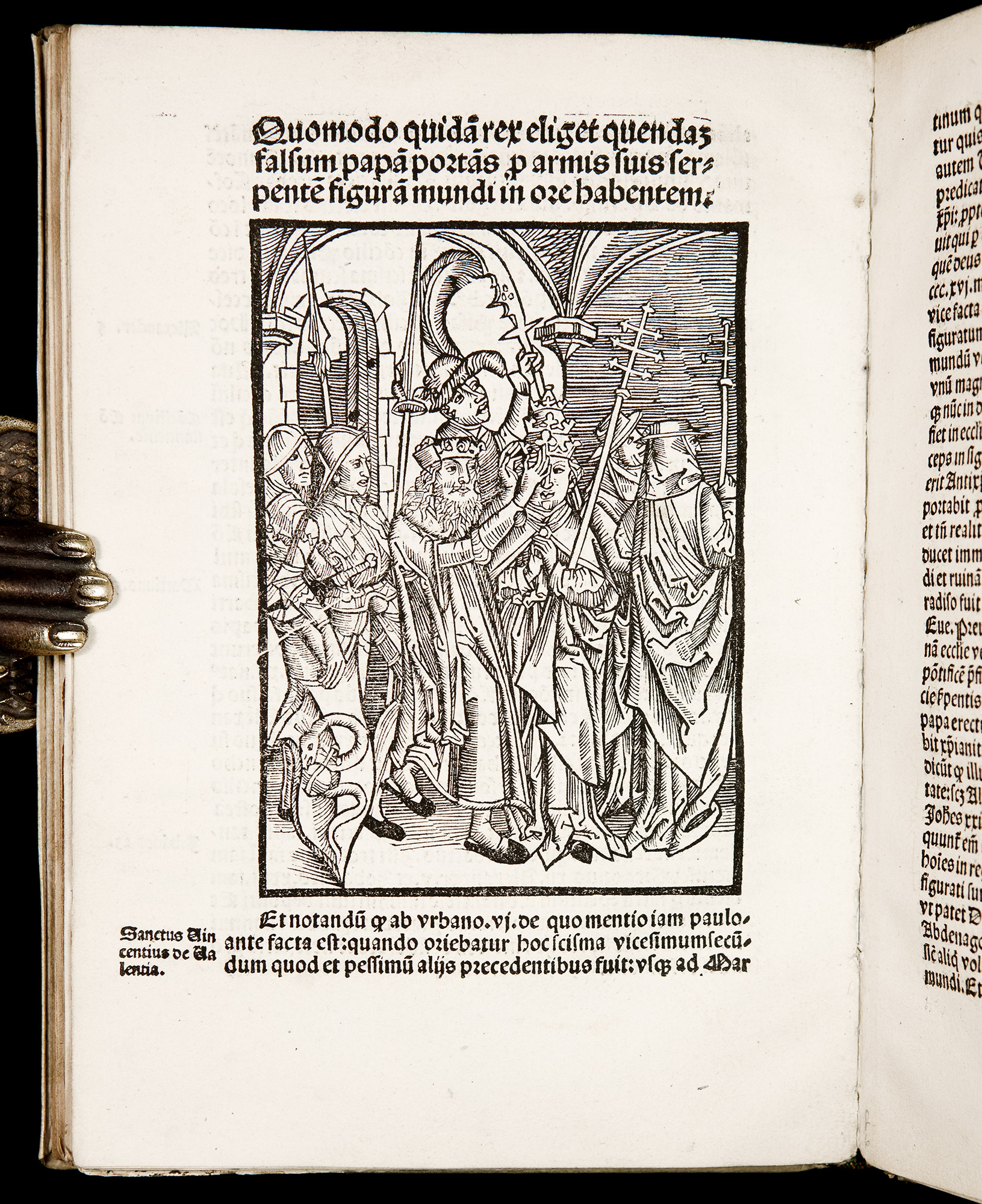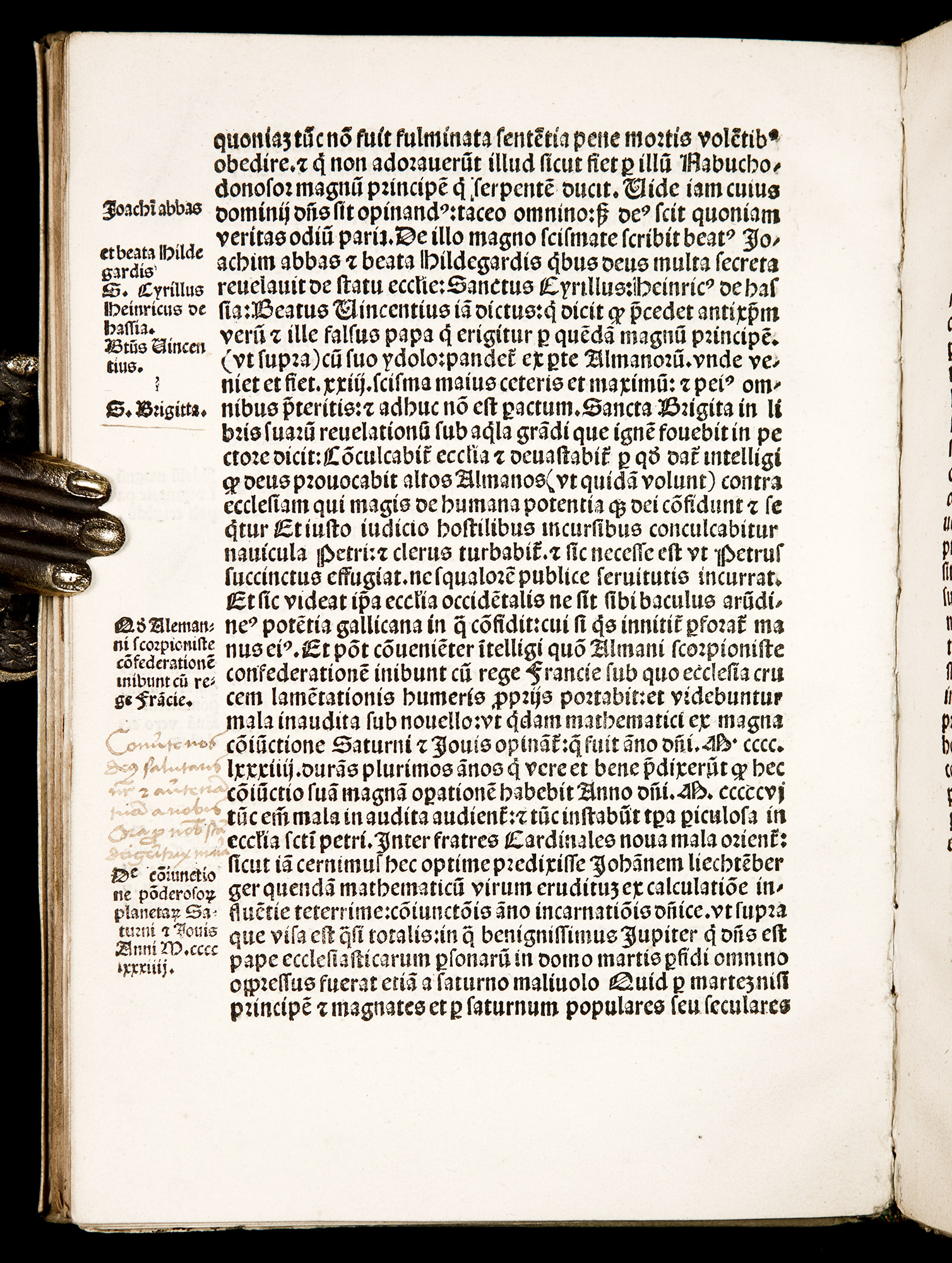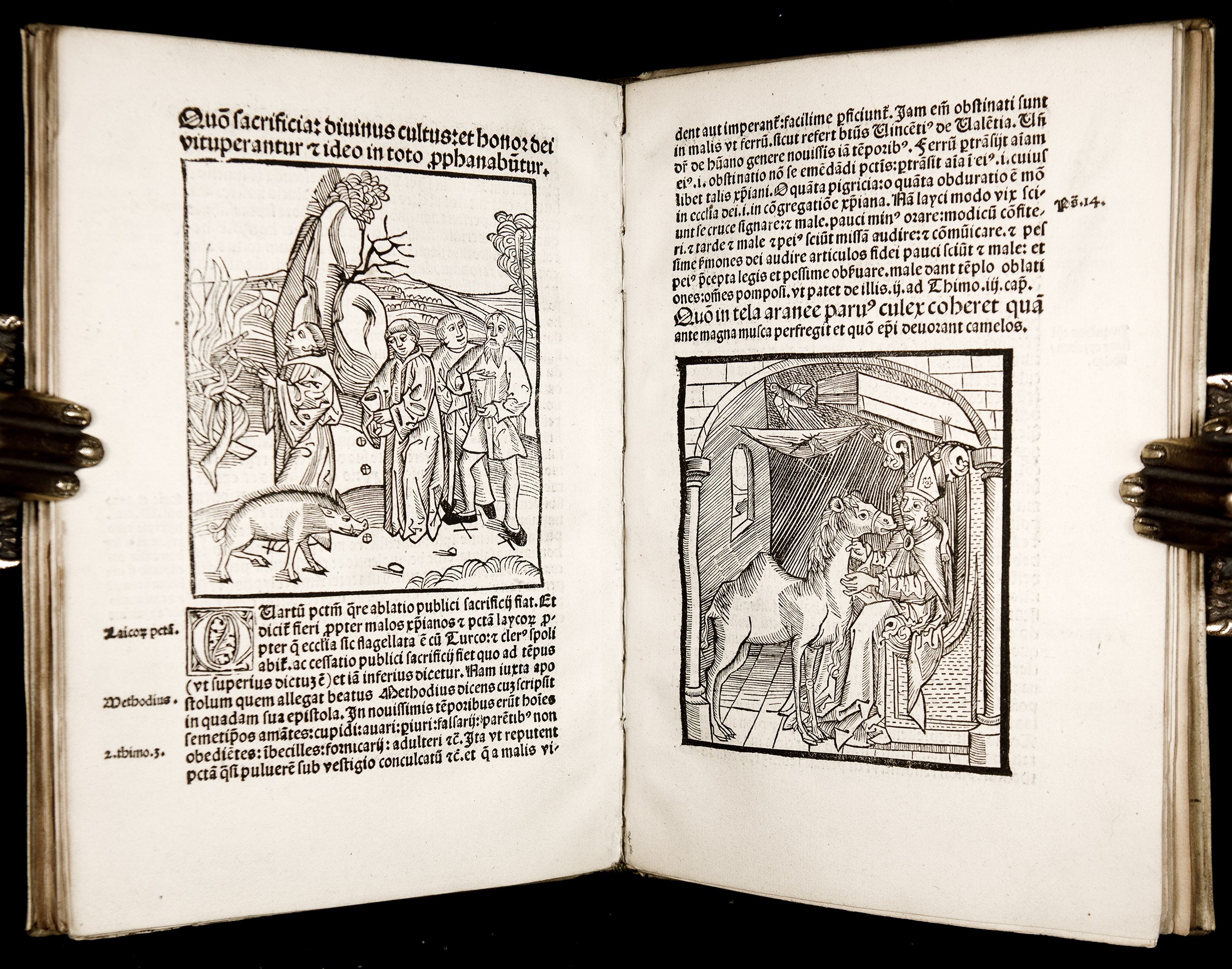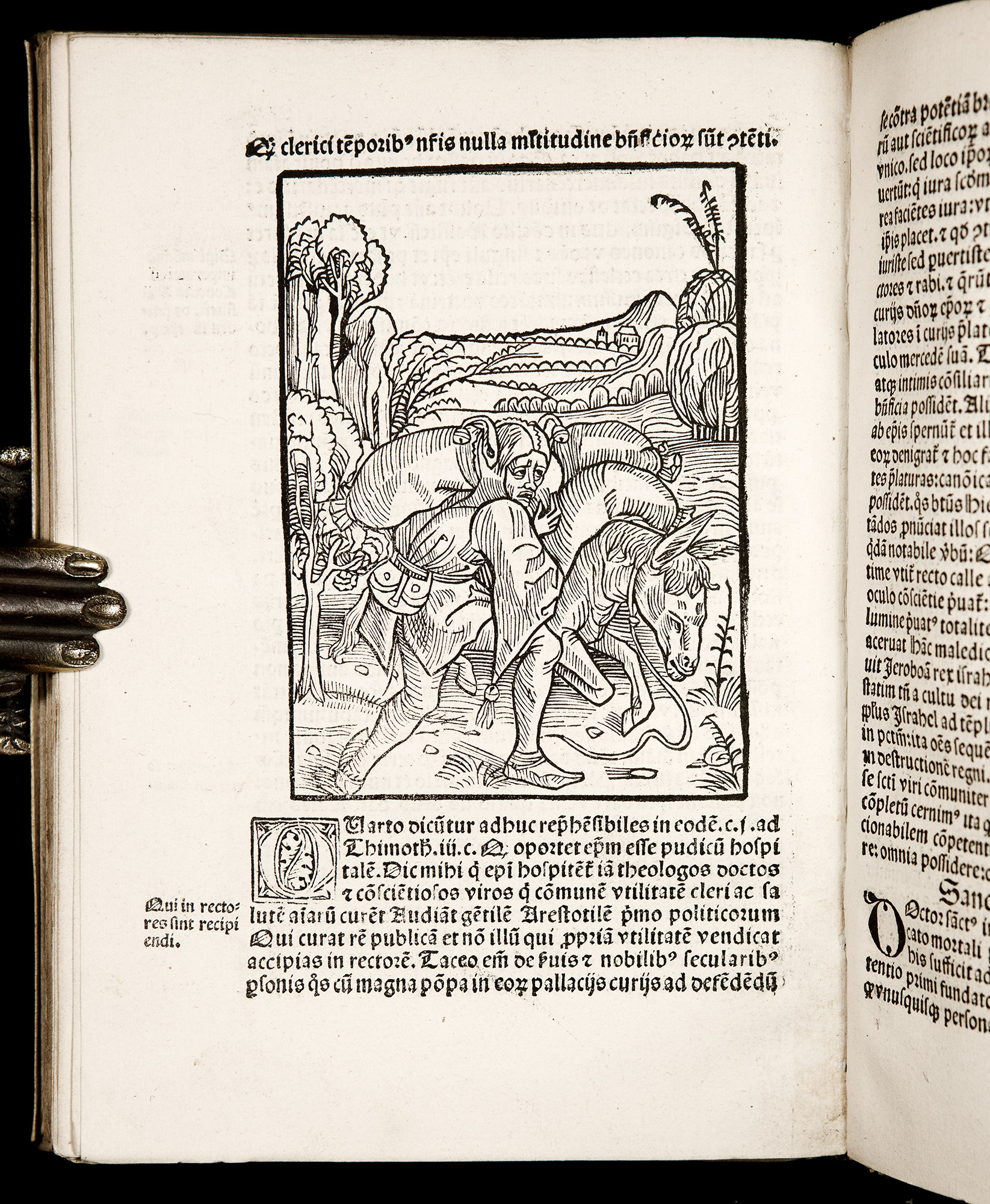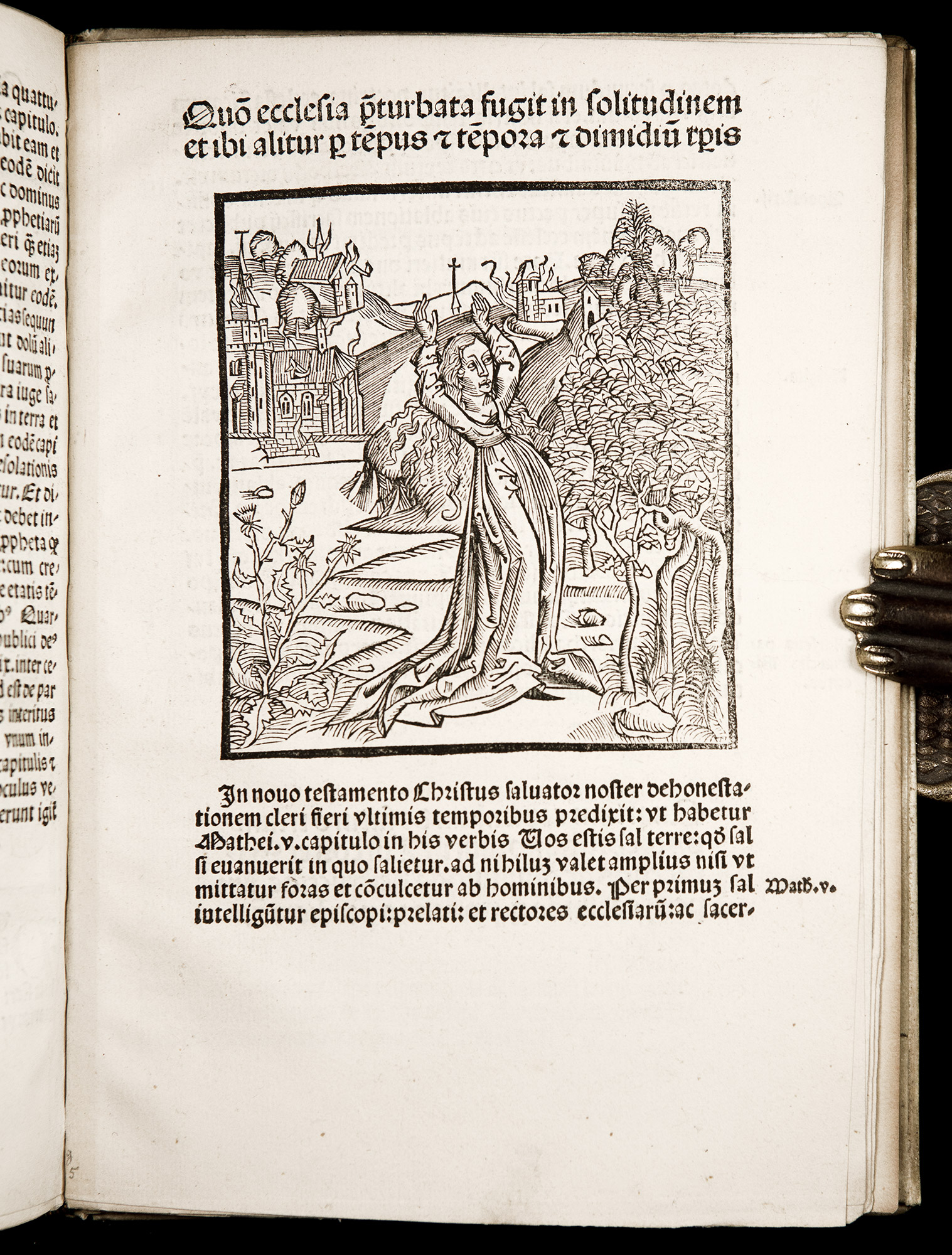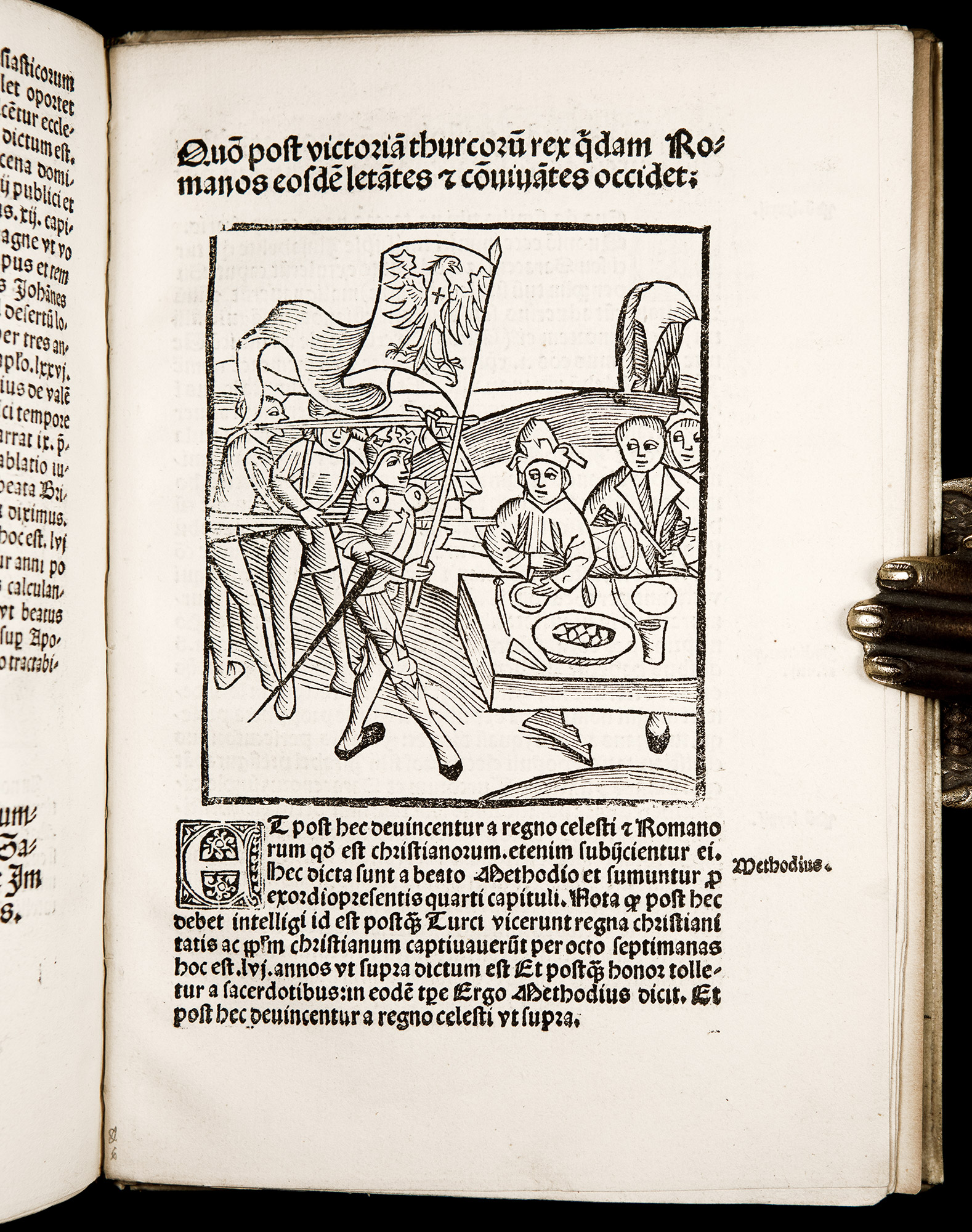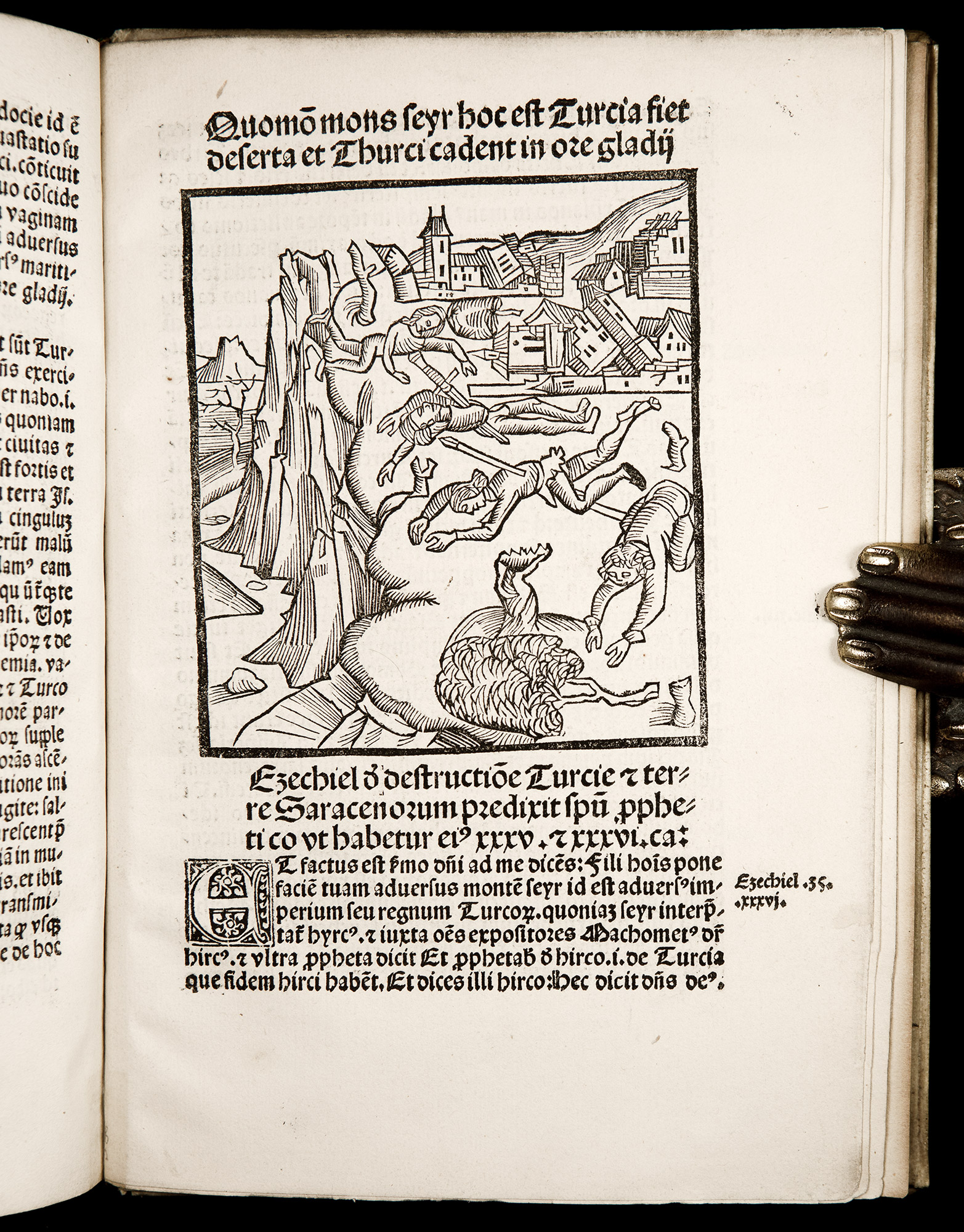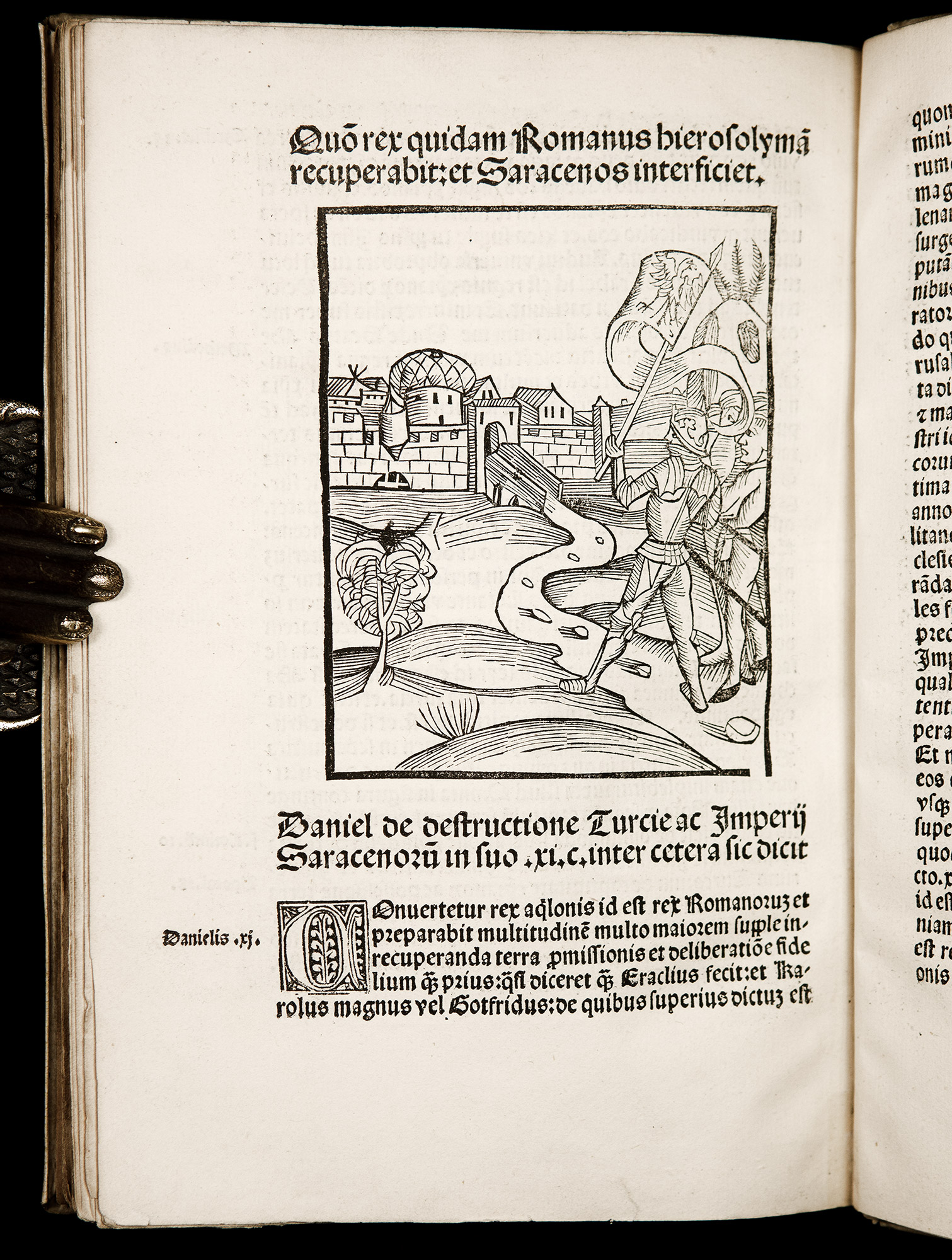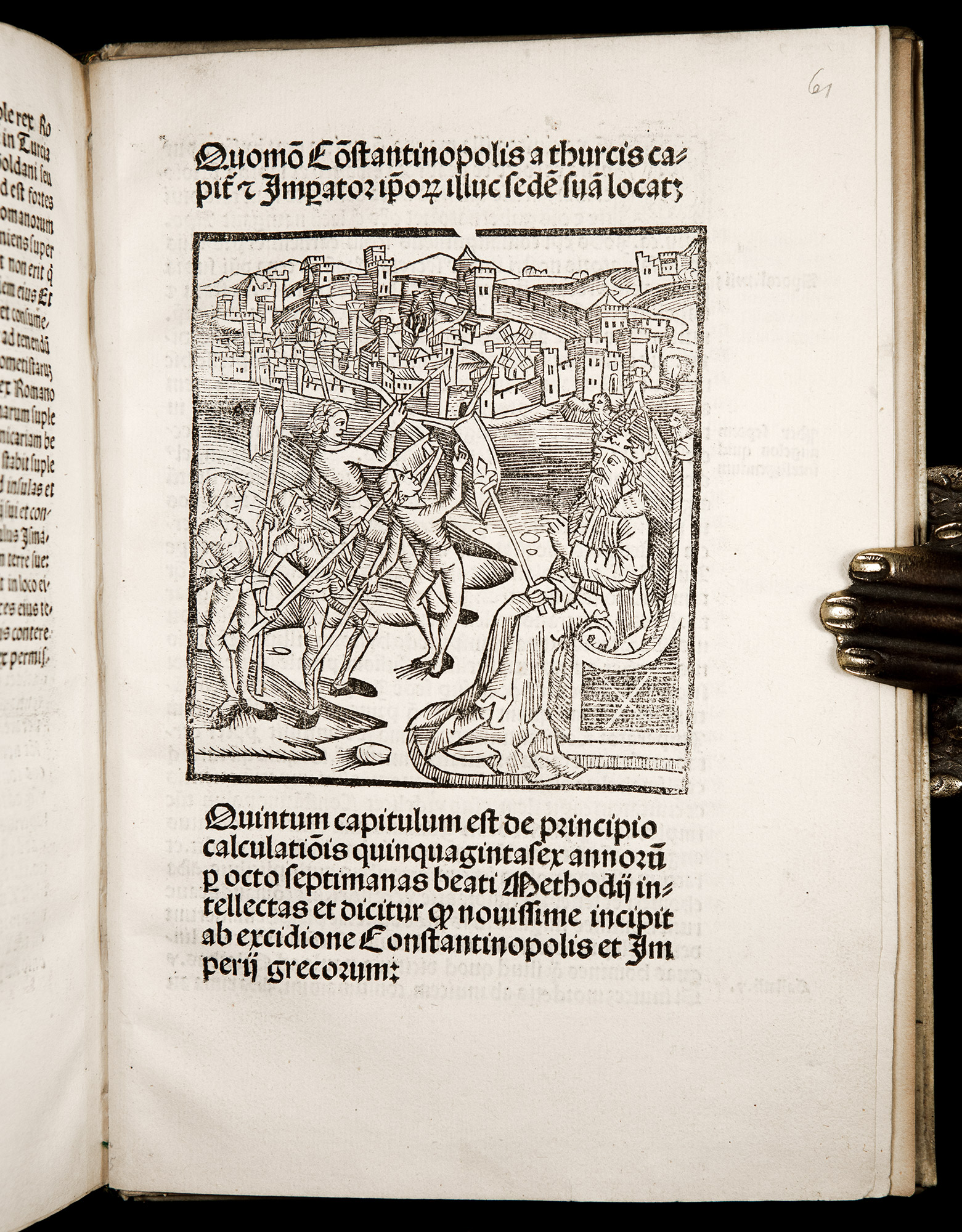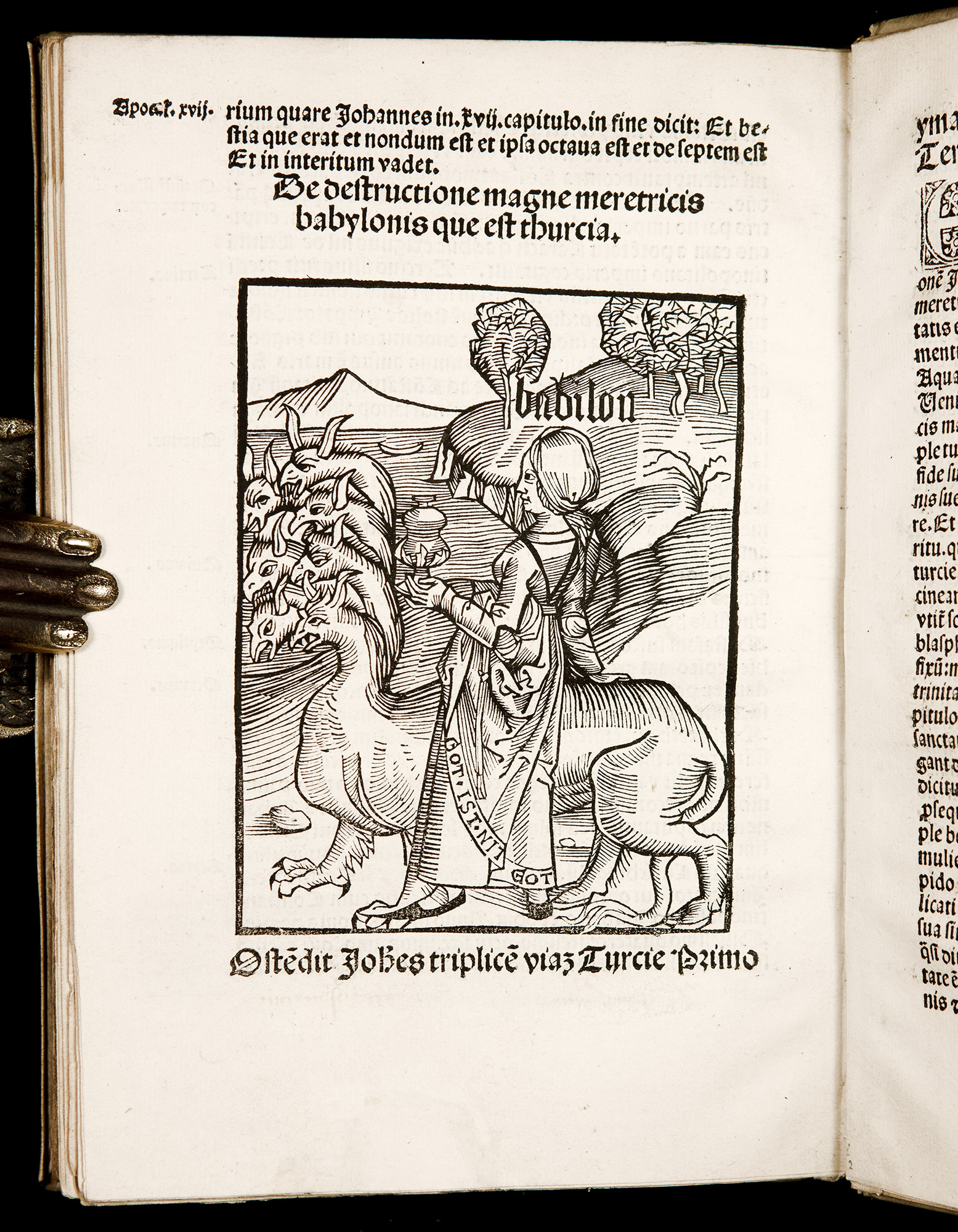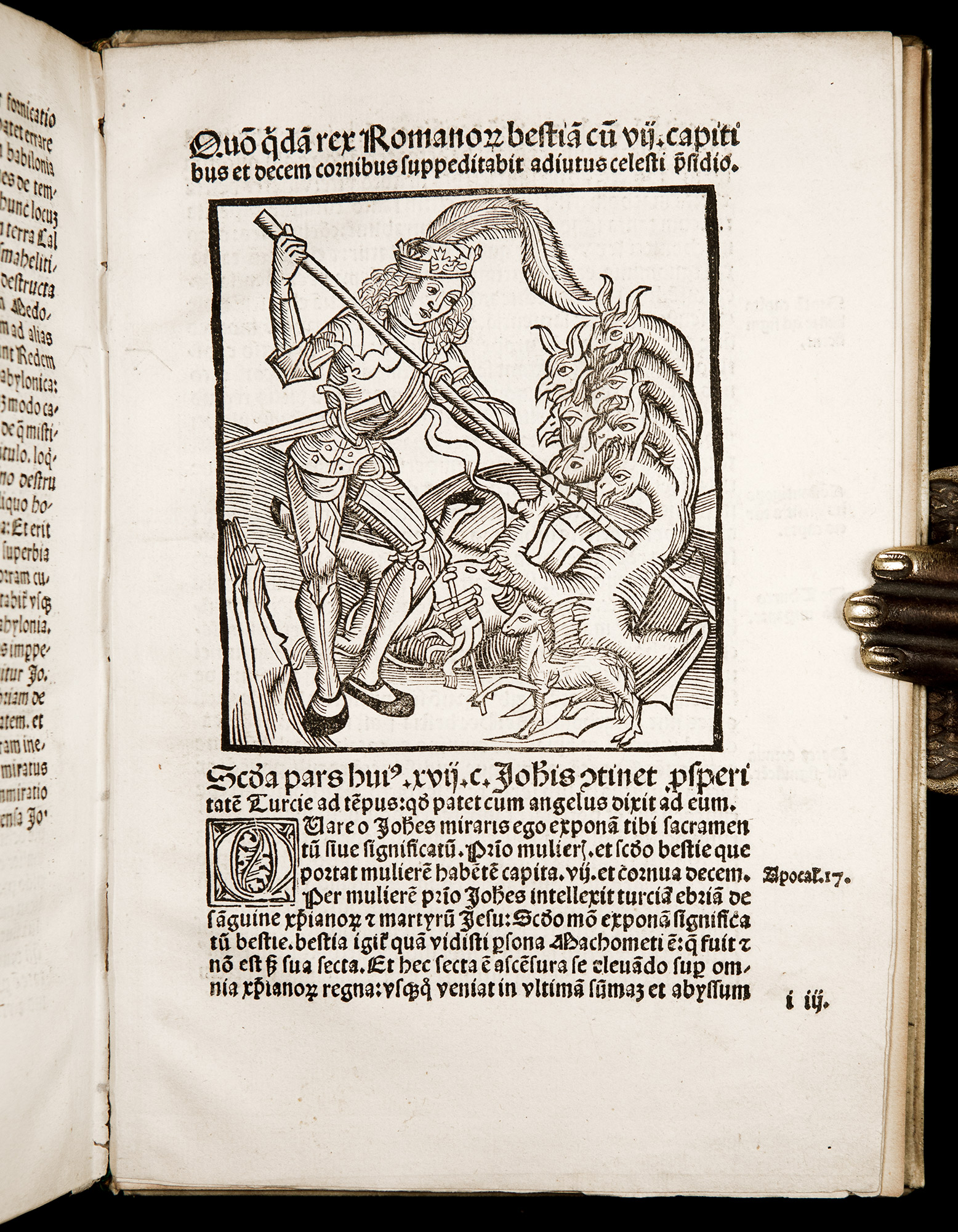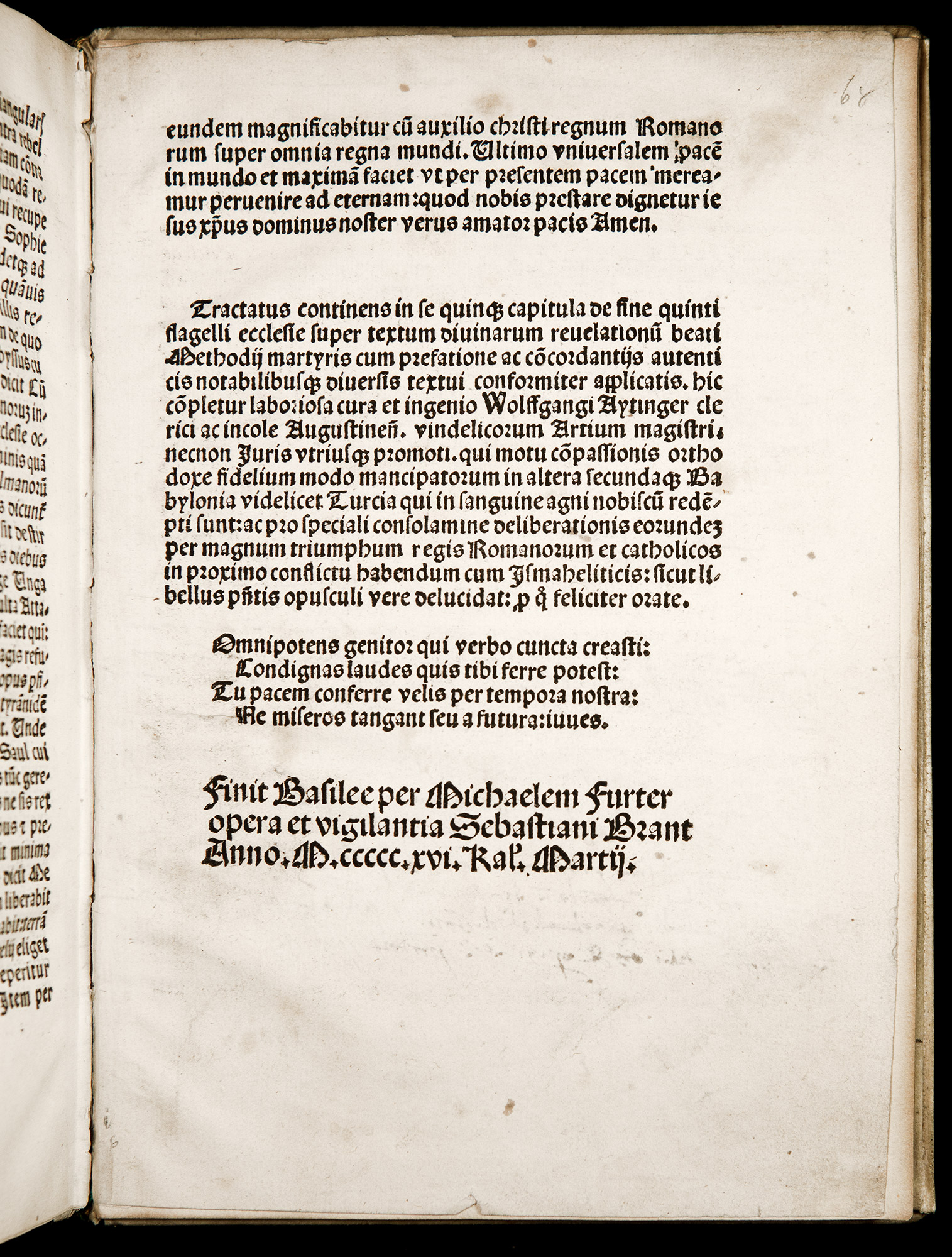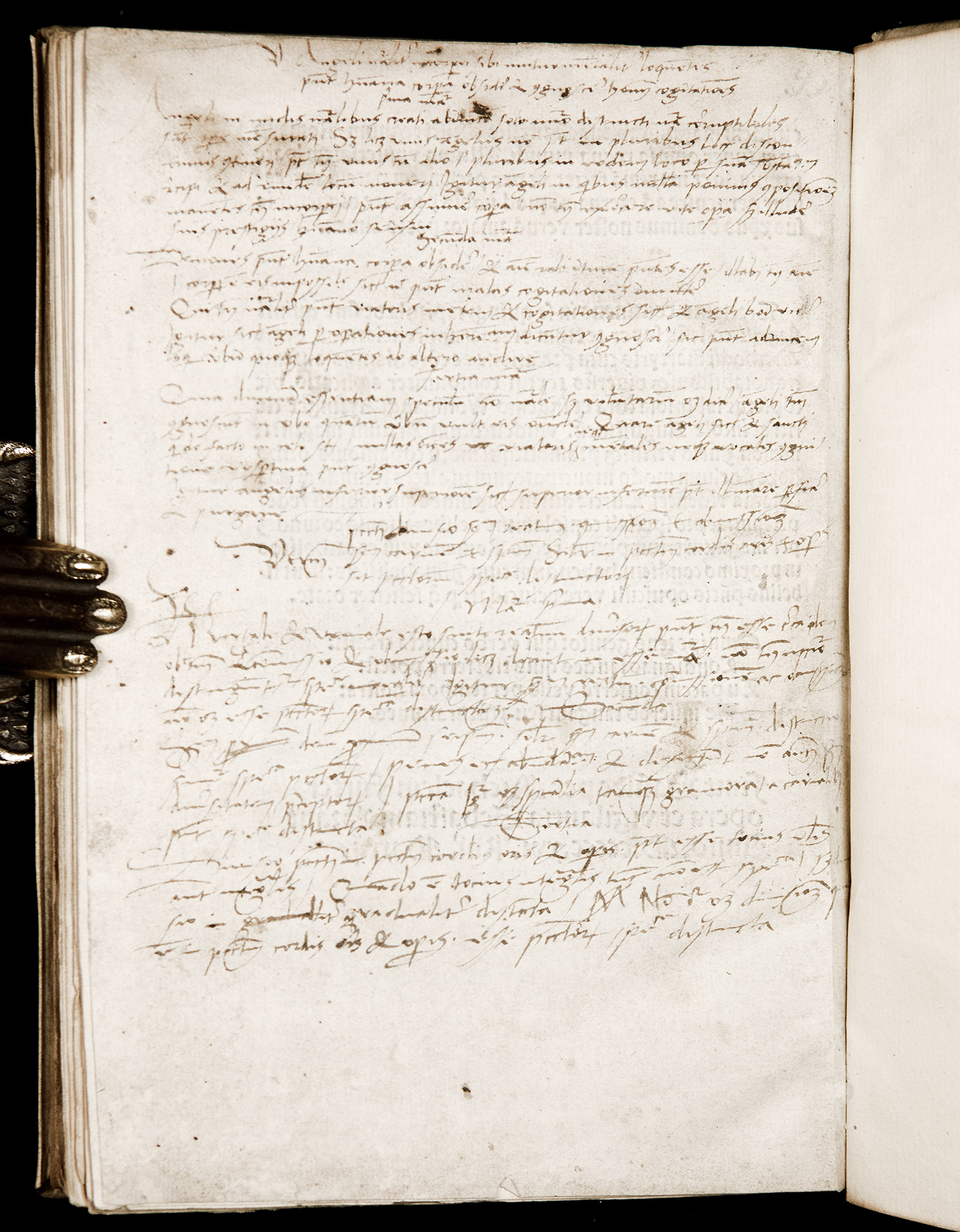
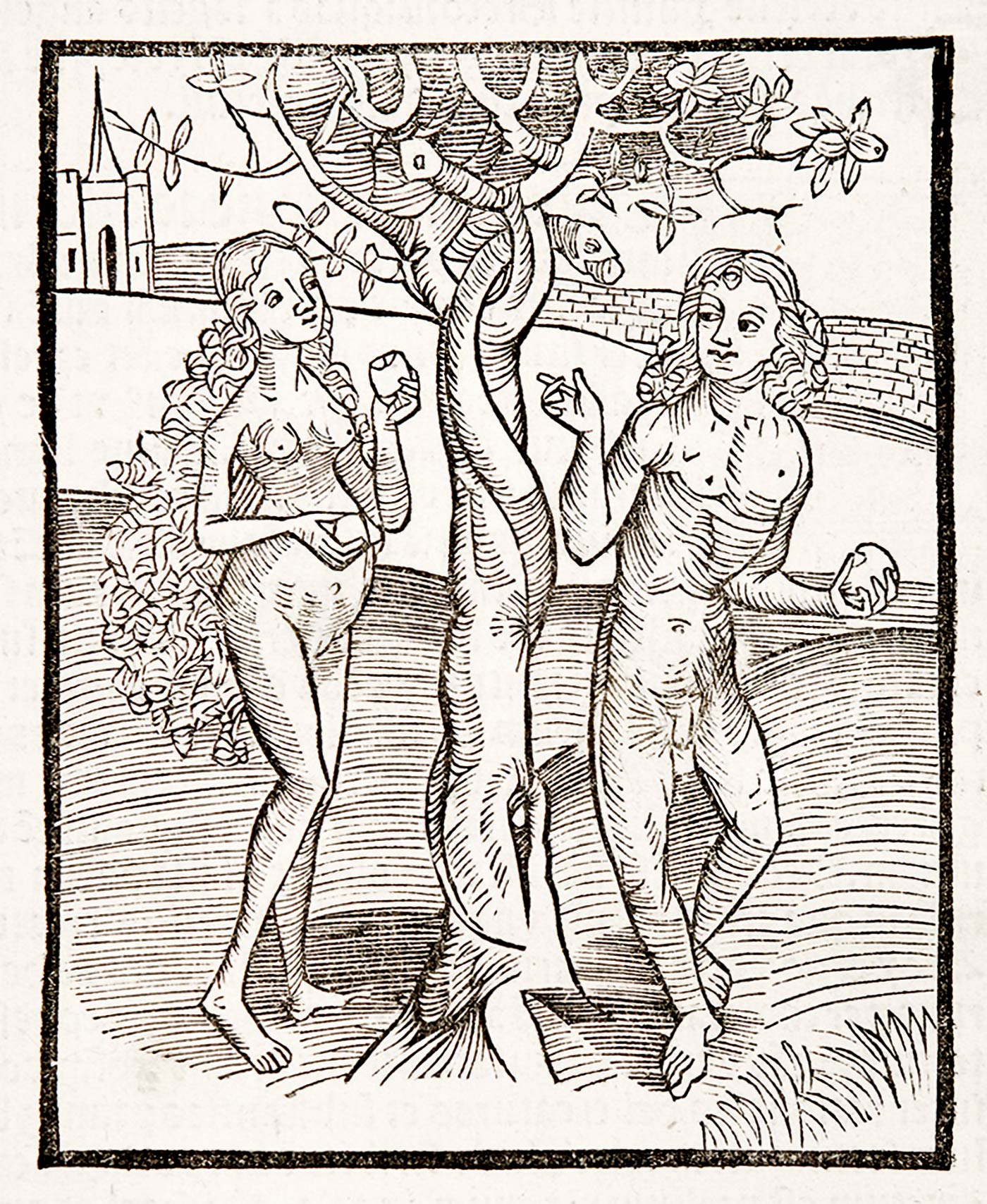
[Early Illustrated Books] [Incunabula - Basel] [Christian Eschatology and Apocalyptic literature] [Christianity and Islam in Middle Ages]
[The Apocalypse of Pseudo-Methodius]
St. Methodius, Revelationes divinae a sanctis angelis factae. (With) Wolfgang Aytinger. Tractatus super Methodium. (Edited by Sebastian Brant.)
Basel: Michael Furter, 14 February 1500.
SOLD
RARE: ISTC locates less than 27 complete copies worldwide (of which only 6 are in the U.S.).
SECOND ILLUSTRATED EDITION, with the full series of 61 striking woodcuts (from 55 woodblocks, with 6 repeats). The same series was used in Furter's 1498 first edition. The woodcuts are stylistically close to those in the Passio Meynradus (Furter, 1496) and may be by the same artist, generally referred to as Master of the Verardus; one woodcut (on g1v) was used in Brant's famous Das Narrenschiff (‘The Ship of Fools’).
Notable among the woodcuts is the depiction of the birth of the Antichrist, which is also one of the earliest printed illustrations of a Caesarian section birth. There is a long iconographic tradition of linking the Antichrist with a Caesarian birth, hinting at the suspicion and distrust surrounding this "unnatural" procedure during the Middle Ages.
Sebastian Brant, who at that time was teaching Law at Basel, was apparently instigated to publish this illustrated edition of Pseudo-Methodius by his friend Johannes Meder, to whom Brant addresses his dedicatory preface to this edition. Meder was a Franciscan residing at Basel from 1495 to 1502, whose illustrated collection of Lenten sermons was printed by Furter in 1495 and 1497. As in many other books he wrote or edited, Brant had numerous illustrations added to the text of the Revelationes in order to reinforce visually the verbal message of the text, particularly for the benefit of the less educated public who could not read Latin fluently. He writes in the preface that "in pictures the ignorant may see that which they ought to follow; in this they who are illiterate read."
“The crown of Eastern Christian apocalyptic literature is the treatise attributed to Methodius of Patara, a martyr bishop who died in the early 4th century. After the Book of Daniel and the Revelation of John it was among the most widespread of medieval apocalyptic texts. […] [it is] a politico-religious manifesto, rejecting every kind of defeatism or collaboration with the Moslems, warning against reliance on the weak and distant ruler of Ethiopia as a will-o-the wisp, calling for war against the conquerors, and preaching that salvation from the Moslem yoke could come only from one source, the most powerful Christian monarch of the time, the basileus at Byzantium. […] The Relevations of Pseud-Methodius is the earliest surviving witness to the legend of the Last World Emperor. […] The influence of the Pseudo-Methodius in the West was immense.” (Bernard McGinn, Visions of the End: Apocalyptic Traditions in the Middle Ages, p.70)
In the late 15th-century the Revelationes were re-interpreted by Augsburg monk Wolfgang Aytinger in the context of a planned anti-Turkish crusade. In his hands they became an agent for exciting Christian wrath against the Turks. Aytinger added the Revelationes his own explanatory essay Tractatus super Methodium, interpreting the work’s significance for contemporary audiences, while equating the Ottoman Turks with Gog and Magog as actors in the End Time drama. “For Aytinger the time of apocalyptic crisis began with the Fall of Constantinople and would end with the Last Emperor's victory over the Turks predicted for 1509. Aytinger has two possible candidates for the role [of the Last Emperor] - Philip of Burgundy, and Ladislaus the king of Poland, Hungary and Bohemia.” (McGinn, Op. cit., p.271)
Aytinger in his commentary also brings to bear other prophecies by such ancient and medieval authorities as Merlin, Hildegard von Bingen, Birgitta of Sweden, and Petrus de Alliaco.
“There [was a] medieval tradition, […] that mitigated the pessimistic outlook of St. Augustine on temporal existence, holding out more hopeful ‘chiliastic’ notions of the end. […] [It] was originally of eastern Christian provenance and had long been ascribed to Methodius, the 4th-century Greek bishop of Olympus, martyred under the Roman emperor Diocletian in Chalcis. Entitled the Apocalypse, it purported to be a vision received by Methodius but was, in fact, authored by an anonymous seventh-century Syriac writer, today known as Pseudo-Methodius.
“The Apocalypse of Pseudo-Methodius drew on the fourth-century Tiburtine Sibyl, a prophecy of the advent of a Last World emperor, the ‘king of the Greeks or Romans,’ who would vanquish the enemies of Christianity and whose reign would usher in a period of peace before the final onslaught of the Antichrist. The Antichrist would be assisted by the race of Gog and Magog (mentioned in John's Apocalypse), who had been contained in Asia beyond the Caspian Mountains by Alexander the Great during his Eastern conquests but who would break loose into the world during the End Times. The Apocalypse was still very influential during the fifteenth century, being published in several editions, including one instigated by the German Franciscan Johann Meder that was published in Basel in 1498 by the German humanist Sebastian Brant, author of A Ship of Fools (1494) […].
“By the 15th century, however, the apocalyptic tradition of Pseudo-Methodius had become fully mediated by late Scholastic Latin commentaries and editions [...] that reflected shifting political concerns of the age. Thus, Pseudo-Methodius's Apocalypse had originally associated the enemies of Christianity defeated by the Last World Emperor with the ‘Ishmaelites’. While the Ishmaelites were still in the thirteenth century interpreted to be the Tartars (or Mongols), who had recently invaded eastern Europe, by the fifteenth century - especially in the aftermath of the Ottoman conquest of Constantinople in 1453 - a more common interpretation was that the enemies of Christianity vanquished by the Last World emperor were the Muslims.” (Ralph Bauer, The Alchemy of Conquest: Science, Religion, and the Secrets of the New World)
“The 1498 [and 1500] Latin edition[s] of ‘Revelations’ by Pseudo-Methodius […] edited by Sebastian Brant and published in Basel contain images linking Ottoman Turks to the unclean races behind the Caspian Gates […]. An illustration of the scene depicts ominous-looking devils above and allows only a view of the heads of the people behind the mountains, some of whom appear to be wearing turbans. In the lower left corner Alexander, dressed as a knight, kneels on a piece of land separated from the mountains by the Caspian Sea. Another illustration in the same text, of Gog and Magog breaking out of the Caspian Gates together with the unclean races, is more explicit in its reference to Turks. It depicts foot soldiers wielding pickaxes in the foreground with the armies of Gog and Magog on horseback in the background. Apart from their crowned king, the majority of the riders wear turbans.” (Charlotte Colding Smith, Images of Islam, 1453–1600: Turks in Germany and Central Europe, p.23)
Written in Syriac in the late 7th century, the ‘Apocalypse’ (or, as it is termed in this edition the ‘Divine Revelations’) of Pseudo-Methodius shaped and influenced Christian eschatological thinking throughout the Middle Ages. Falsely attributed to Methodius of Olympus, a 4th-century Church Father, the work was In all likelihood written in the final decade of the seventh century, by a Miaphysite Christian, in Northern Syria, and attempts to make sense of the Islamic conquest of the Near East.
The Apocalypse is indebted to earlier Syriac works, including the Cave of Treasures, the Julian Romance and the Syriac version of the Alexander Romance. The Apocalypse begins with a history of the world, starting with Adam and Eve in the Garden of Eden, through to the Muslim conquests, and into the End-times. It incorporates numerous aspects of Christian eschatology such as the invasion of Gog and Magog, the rise of the Antichrist, and the tribulations that precede the end of the world. Pseudo-Methodius, however, adds a new element to Christian eschatology: the rise of a messianic Roman emperor, echoing the 4th-century AD prophecy attributed to the legendary Tiburtine Sibyl. This ‘Last Emperor’ will save the Christian lands from "the sons of Ishmael", place his crown upon the cross "for the sake of the common salvation of all" thereby saving Christendom as a whole. The ‘Last Emperor’ figure would remain in Christian apocalyptic literature until the end of the medieval period.
One notable feature of Pseudo-Methodius is the references to sexuality in regard to Christian behavior during the End Times — specifically discussing swinging, homosexuality, and cross-dressing as indicators of a sinful and decadent society. It is only then that the text says the "sons of Ishmael", that is Muslims, will emerge from the desert of Ethribus to inflict God's punishment upon the Christians who "slipped into depravity". The work is also characterized by vivid descriptions of brutality: accounts of drinking the blood of cattle, stabbing pregnant women, and feeding babies to animals permeate the text.
By the early 8th century, the Apocalypse was translated into Greek and then from Greek into Latin. The earliest Latin witness is a codex dated to 727. The Latin translation was made by a certain Petrus Monachus in the Frankish kingdom.
The editor if the work, Sebastian Brant (1457 — 1521), notable German humanist and satirical poet best known for his Das Narrenschiff (1494; The Ship of Fools), the most popular German literary work of the 15th century. Brant studied in Basel, where he received his B.A. in 1477 and Doctor of Laws in 1489; he taught in the law faculty there from 1484 to 1500. In 1500, when Basel joined the Swiss Confederation (1499), he returned to Strassburg, where in 1503 he was made municipal secretary. Maximilian I appointed him imperial councillor and count palatine.
Physical description:
Chancery Quarto, leaves measure 20.5 cm x 14 cm. Bound in later (18th-century?) full vellum over rigid boards; flat spine with hand-written title.
68 unnumbered leaves (forming 136 pages).
Collation: a-g8 h-i6.
COMPLETE. (Leaves d5-8 misbound before d3 due to binder’s error, but all present.)
Profusely illustrated with 61 fine large woodcuts (from 55 blocks with six repeats); also with several Maiblumen, lombard and other decorative woodcut initials.
Text printed in gothic letter (Type: 156.G, 6:106G, 1:83G, 4:64G), in single column, 36-38 lines per page, with printed marginal notes.
Contents: a1r: title-page (with a large woodcut); a1v-2r: prefatory epistle by Sebastian Brant to Johannes Meder; a2v: large woodcut, under header ‘De prevaricatione angelice nature...’; a3r-4r: Aytinger’s preface; a4v: large woodcut, under header ‘De primorum parentum…’; a5r-d4v: pseudo-Methodius’ Revelationes divinae; d5r-i6r: Aytinger’s Tractatus super Methodium (opening with a large woodcut under header ‘De civitate Hierosolyma…’ on a5r); i6r: four lines of postfatory verses (Incipit: ‘Omnipotens genitor qui verbo cuncta creasti…’) followed by a colophon; i6v blank.
Bibliographic references:
BMC III, 786 (IA. 37813); Goff M-525; Schreiber 4649; Schramm XXII, p.43; GW M23062; BSB-Ink M-354; Wilhelmi, Brant, 447. Van der Haegen D 47.
Provenance:
From the collection of Paul Schmidt (1834-1907), Alsatian French businessman and book collector. Schmidt, who lived mist of his life in Paris, had trained as a chemist and owned a factory; he may also have run a printing business. He was a deacon in the Reformed Church of France and was interested in questions of social welfare, serving as vice-president of the Société internationale pour l'étude des questions d'assistance (International Society for the Study of Social Welfare). However he is best known as a collector of rare books. After his death, his library (containing over 800 rare books, including 280 incunabula) was sold at auction in Paris in April 1910.
Later owned by Hanns-Theo Schmitz-Otto (1908-1992), German bookseller and collector based in Cologne, with his small oval morocco bookplate gilt-stamped with a stylized monogram (resembling early printers’ devices) on front free endpaper, and his small collector’s ticket on front pastedown. Schmitz-Otto donated numerous books to the Cologne University library.
A few marginal notes in a neat 16th-century hand.
Condition:
Very Good antiquarian condition. Complete. Some rubbing and light soiling to vellum; boards slightly bowed (as is often the case with rigid vellum bindings). Internally with occasional light soiling or spotting. Small manuscript marginal notes in a neat 16th-century hand on a few pages (including bottom margin of title), and extensive early manuscript notes to blank verso of the final leaf. The ‘birth if Antichrist’ woodcut on d2r has the outlines of the mother’s breasts carefully erased by a censor(?) without damaging the leaf; all other woodcuts completely uncensored and intact (including the ‘Adam & Eve’ on a4v with its full frontal nudity, which is often found mutilated). Front endpapers with former owners’ bookplates and some bibliographical notes in pencil; rear pastedown with a clipping from a mid-20th-century German catalogue tipped in. In all, an attractive, clean, well-margined example of this rare illustrated incunabulum.
